Paul van Yperen's Blog, page 445
September 4, 2013
Dick Rivers
French singer and actor Dick Rivers (1945) was - with Eddy Mitchell and Johnny Hallyday - one of the three stars who introduced Rock and Roll in France in the early 1960s. In later life, he also appeared in some films.
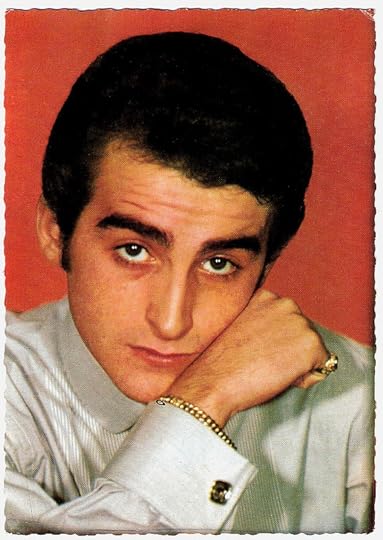
French postcard by PSG, no. 923. Photo: Patrick Bertrand.
The Wild Cats
Dick Rivers was born Hervé Fornieri in in Villefranche-sur-Mer in southern France in 1945. He was fascinated by America, the juke box and Rock and Roll. He admired Elvis Presley, who highly influenced both his singing and his looks.
In 1960, at the age of fifteen, Hervé founded with three friends, guitarists Jean-Claude and Gerard Roboly and bassist Gerard Jacquemus, the group Les Chats Sauvages (The Wild Cats). With his black hair slicked back, his never worn jeans and his cowboy boots he was the lead singer. His stage name came from the character (Deke Rivers) that Presley played in his second film, Loving You (Hal Kanter, 1957).
In February 1961, the British music magazine, NME , reported that Rivers concert at the Palais des Sports de Paris, whilst headlining with Vince Taylor, had turned into a full-scale riot. Between May 1961 and June 1962, he recorded with Les Chats Sauvages more than a hundred songs, and they sold more than 2 million albums.
Big hits were Ma petite amie est vache (My girlfriend is a cow), Twist à Saint-Tropez (Twist in Saint-Tropez) and Est-ce que tu le sais (Do you know). The band’s success extended to all French-speaking countries, Belgium, Switzerland and Quebec, where they attracted large crowds.
But then, Rivers suddenly left Les Chats Sauvages.
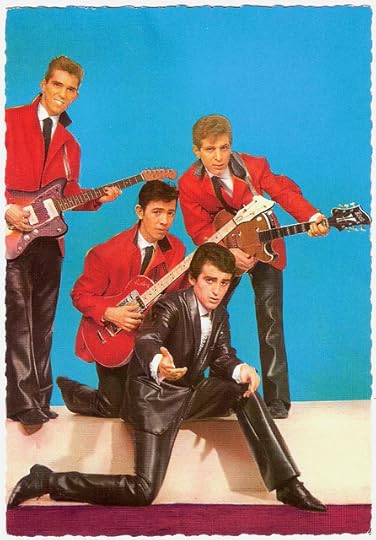
French postcard by E.D.U.G., no. 228. Photo: Sam Lévin .
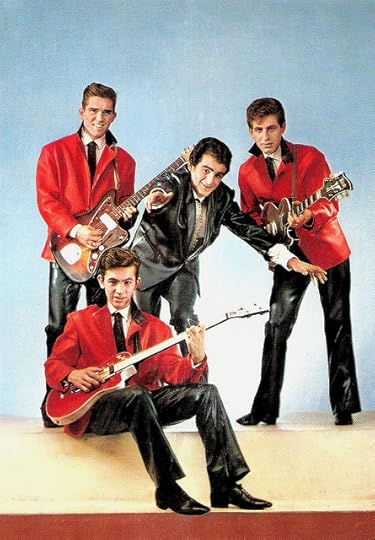
French postcard by Editions P.I., Paris, no. 1095. Photo: Sam Lévin .
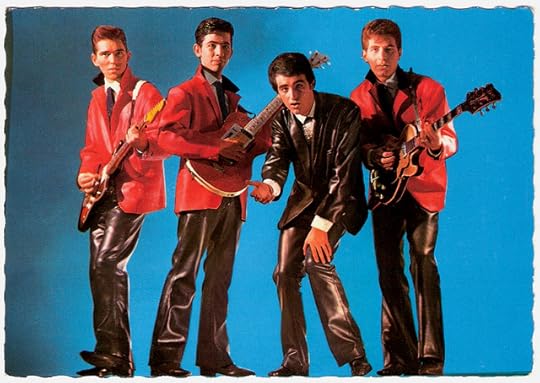
French postcard by E.D.U.G., no. 227. Photo: Sam Lévin .
Mister D
In September 1962, Dick Rivers released his solo single Baby John which sold 200,000 copies. It was the start of a long and successful solo career, with more than thirty albums (three in English) and many singles.
Among his hits were Tu n'es plus là (1963), the French version of Roy Orbison’s Blue Bayou, and Va t'en va t'en (1965), based on Go Now by the Moody Blues.
In the 1970s, his music seemed outdated. For ten years, between 1982 and 1992, he hosted a program devoted to rock on Radio Monte Carlo.
In 1994, a first collection of his old successes, Very-Dick was certified gold the following year. He started to record new music. In 1999, Dick made his first film La Candide Madame Duff/The Candid Lady Duff (Jean-Pierre Mocky, 1999) and gave about 60 concerts in France, Belgium and Switzerland.
In 2003, Rivers played in the comedy Le Furet/The Ferret (Jean-Pierre Mocky, 2003) with Jacques Villeret and Michel Serrault. The following year he appeared on stage in the play Les Paravents (The Screens) by Jean Genet, at the Théâtre National de Chaillot. It was a success.
Furthermore, he was the French voice of Shere Khan in Jungle Book 2 (Steve Trenbirth, 2003) and he also gave his voice to Arthur et les Minimoys/Arthur and the Invisibles (Luc Besson, 2006). On television he appeared in Mon amour de fantôme/Phantom Love (Arnaud Sélignac, 2007).
His latest album, called Mister D, was released in 2011 to celebrate his 50-year career. At the same time, a book with the same title was published containing his memoirs collected by Sam Bernett. He returned to the stage and in 2012, he was on tour in France.
Dick Rivers lives in an apartment in Montmartre in Paris and on a ranch in the Toulouse region. He is married to Micheline Davis and has an adopted daughter, Natala, who lived for three years with American director George Lucas.
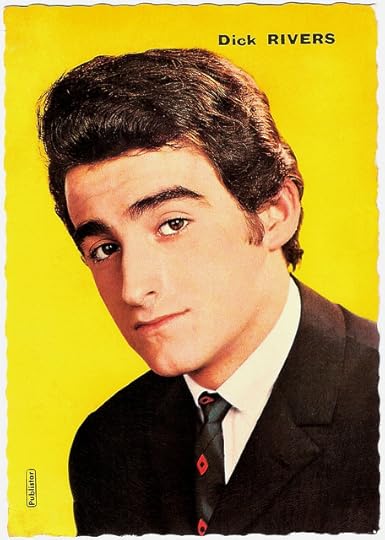
French collector's card by Publistar.
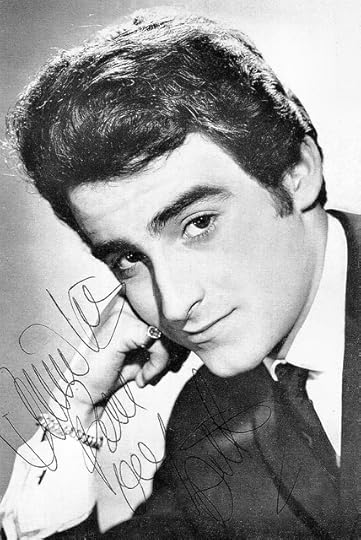
French promotion card by Pathé Marconi, no. 5-63. Photo: Vallois.
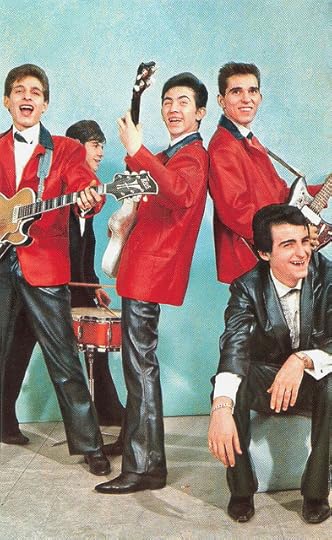
French postcard by P.I., no. 1085, offered by Corvisart. Photo: Jean Mainbourg.
Sources: RFI Musique (French), Dick Rivers.com (French), Wikipedia (French and English) and .

French postcard by PSG, no. 923. Photo: Patrick Bertrand.
The Wild Cats
Dick Rivers was born Hervé Fornieri in in Villefranche-sur-Mer in southern France in 1945. He was fascinated by America, the juke box and Rock and Roll. He admired Elvis Presley, who highly influenced both his singing and his looks.
In 1960, at the age of fifteen, Hervé founded with three friends, guitarists Jean-Claude and Gerard Roboly and bassist Gerard Jacquemus, the group Les Chats Sauvages (The Wild Cats). With his black hair slicked back, his never worn jeans and his cowboy boots he was the lead singer. His stage name came from the character (Deke Rivers) that Presley played in his second film, Loving You (Hal Kanter, 1957).
In February 1961, the British music magazine, NME , reported that Rivers concert at the Palais des Sports de Paris, whilst headlining with Vince Taylor, had turned into a full-scale riot. Between May 1961 and June 1962, he recorded with Les Chats Sauvages more than a hundred songs, and they sold more than 2 million albums.
Big hits were Ma petite amie est vache (My girlfriend is a cow), Twist à Saint-Tropez (Twist in Saint-Tropez) and Est-ce que tu le sais (Do you know). The band’s success extended to all French-speaking countries, Belgium, Switzerland and Quebec, where they attracted large crowds.
But then, Rivers suddenly left Les Chats Sauvages.

French postcard by E.D.U.G., no. 228. Photo: Sam Lévin .

French postcard by Editions P.I., Paris, no. 1095. Photo: Sam Lévin .

French postcard by E.D.U.G., no. 227. Photo: Sam Lévin .
Mister D
In September 1962, Dick Rivers released his solo single Baby John which sold 200,000 copies. It was the start of a long and successful solo career, with more than thirty albums (three in English) and many singles.
Among his hits were Tu n'es plus là (1963), the French version of Roy Orbison’s Blue Bayou, and Va t'en va t'en (1965), based on Go Now by the Moody Blues.
In the 1970s, his music seemed outdated. For ten years, between 1982 and 1992, he hosted a program devoted to rock on Radio Monte Carlo.
In 1994, a first collection of his old successes, Very-Dick was certified gold the following year. He started to record new music. In 1999, Dick made his first film La Candide Madame Duff/The Candid Lady Duff (Jean-Pierre Mocky, 1999) and gave about 60 concerts in France, Belgium and Switzerland.
In 2003, Rivers played in the comedy Le Furet/The Ferret (Jean-Pierre Mocky, 2003) with Jacques Villeret and Michel Serrault. The following year he appeared on stage in the play Les Paravents (The Screens) by Jean Genet, at the Théâtre National de Chaillot. It was a success.
Furthermore, he was the French voice of Shere Khan in Jungle Book 2 (Steve Trenbirth, 2003) and he also gave his voice to Arthur et les Minimoys/Arthur and the Invisibles (Luc Besson, 2006). On television he appeared in Mon amour de fantôme/Phantom Love (Arnaud Sélignac, 2007).
His latest album, called Mister D, was released in 2011 to celebrate his 50-year career. At the same time, a book with the same title was published containing his memoirs collected by Sam Bernett. He returned to the stage and in 2012, he was on tour in France.
Dick Rivers lives in an apartment in Montmartre in Paris and on a ranch in the Toulouse region. He is married to Micheline Davis and has an adopted daughter, Natala, who lived for three years with American director George Lucas.

French collector's card by Publistar.

French promotion card by Pathé Marconi, no. 5-63. Photo: Vallois.

French postcard by P.I., no. 1085, offered by Corvisart. Photo: Jean Mainbourg.
Sources: RFI Musique (French), Dick Rivers.com (French), Wikipedia (French and English) and .
Published on September 04, 2013 23:00
September 3, 2013
Vilma Bánky
Hungarian-born silent film star Vilma Bánky (1901-1991) filmed in Budapest, France, Austria, and Germany, before Sam Goldwyn took her to Hollywood. There she starred opposite silent stars like Rudolph Valentino and Ronald Colman. She became Goldwyn's biggest money maker till sound finished her career.
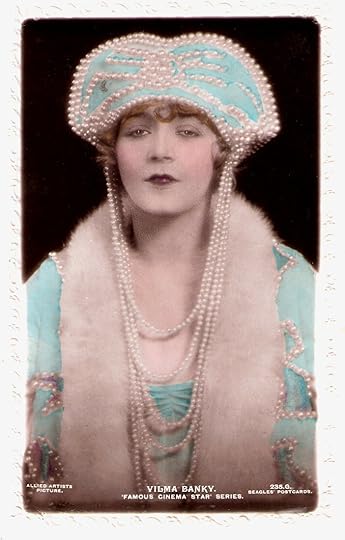
British postcard in the 'Famous Cinema Star' series by J. Beagles & Co, LTD., London, no. 235 G. Photo: Allied Artists Pictures.
Blonde And Violet-Eyed
Vilma Bánky was born Vilma Konsics Bánky to János Konsics Bánky and Katalin Ulbert in Nagydorog, Austria-Hungary, in 1901. (Although reference books give dates ranging from 1898 to 1903).
Her father was a bureau chief under Franz Joseph's Austro-Hungarian Empire. Shortly after her birth, her father was transferred to Budapest, and the family relocated. She had two siblings - an older brother, Gyula (who would later go on to work in Berlin as a writer and cinematographer), and a younger sister, Gisella.
After graduation from secondary school, Bánky took courses to work as a stenographer, but then she was offered a role in a film. Her debut was in the now lost German film Im Letzten Augenblick/The Last Moment (Carl Boese, 1919).
The violet-eyed, blonde beauty was soon asked for Hungarian, Austrian, and French films. To her European productions belong Galathea (Béla Balogh, 1921), A Halott szerelma/The Eye of the Death (Carl Boese, 1922), Das Bildnis/The Picture (Jacques Feyder, 1923), Das verbotene Land/The Forbidden Country (Friedrich Feher, 1924), and Soll man heiraten?/Do You Have to Marry? (Manfred Noa, 1925).
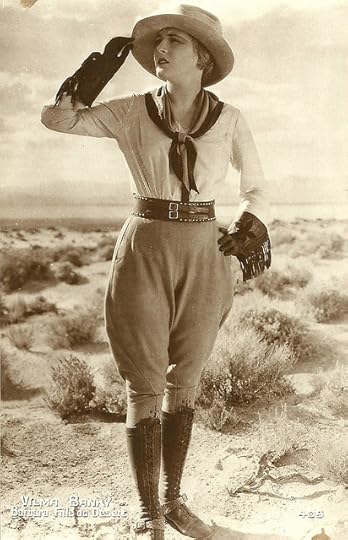
French postcard by Editions Cinémagazine, no. 428. Photo: Vilma Banky in The Winning of Barbara Worth (Henry King, 1926), also with Ronald Colman and a young Gary Cooper, who debuted in this film.
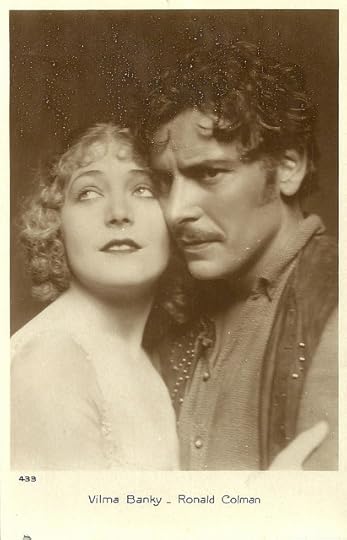
French postcard by Editions Cinémagazine, no. 433, with Ronald Colman .
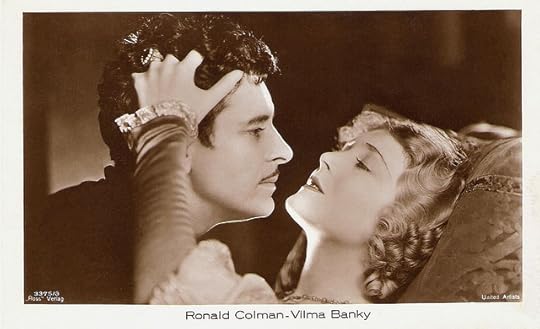
German postcard by Ross Verlag, no. 3375/3, 1928-1929. Photo: United Artists. Publicity still for Two Lovers (Fred Niblo, 1928), with Ronald Colman .
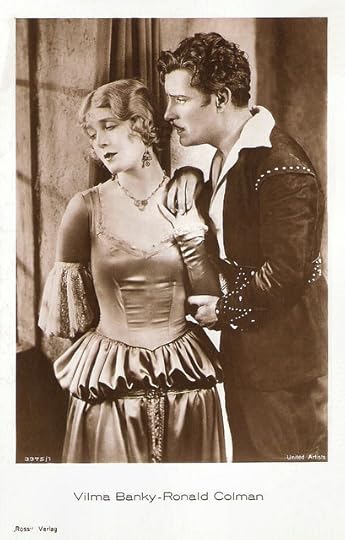
German postcard by Ross Verlag, no. 3375/1, 1928-1929. Photo: United Artists. Publicity still for Two Lovers (Fred Niblo, 1928), with Ronald Colman .
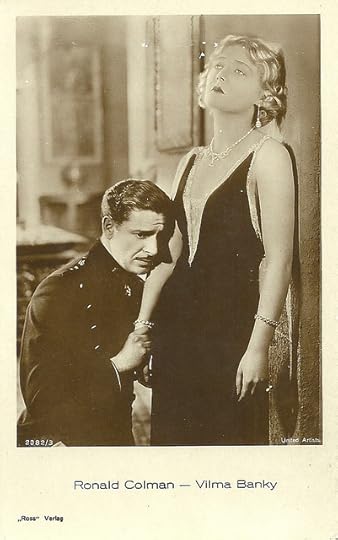
German postcard by Ross Verlag, no. 2082/3, 1927-1928. Photo: United Artists, with Ronald Colman .
The Hungarian Rhapsody
On a trip to Budapest in 1925, Hollywood film producer Samuel Goldwyn discovered and signed Vilma Bánky to a contract. Both her mother and father were vehemently against Bánky's acting career as was her fiancé.
Nonetheless she left for the United States in March 1925, arriving to a great deal of fanfare. She was hailed as ‘The Hungarian Rhapsody’.
Bánky was an immediate hit with American audiences with her first American film, The Dark Angel (George Fitzmaurice, 1925). The New York Times review praised her acting and called her "so exquisite that one is not in the least surprised that she is never forgotten" by her co-star.
This would be the first of five fantastic love stories in which she co-starred with Ronald Colman , including the very popular The Winning of Barbara Worth (Henry King, 1926).
Opposite Rudolph Valentino, she appeared as the daughter of a Russian aristocrat in The Eagle (Clarence Brown, 1925), and as an Arab dancer in his last film The Son of the Sheik (George Fitzmaurice, 1926).
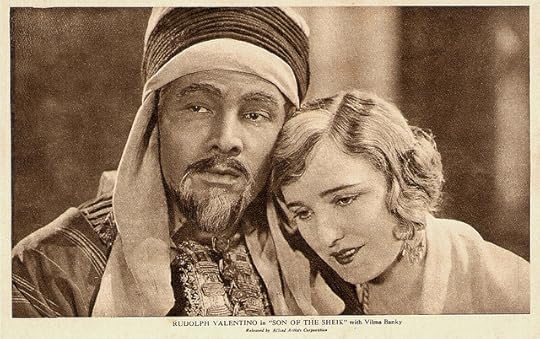
French postcard in a series by Shampoing Butywave. Photo: Allied Artists. Publicity still for The Son of the Sheik (1926), with Rudolph Valentino. The woman portrayed is not Vilma Banky, but Agnes Ayres.
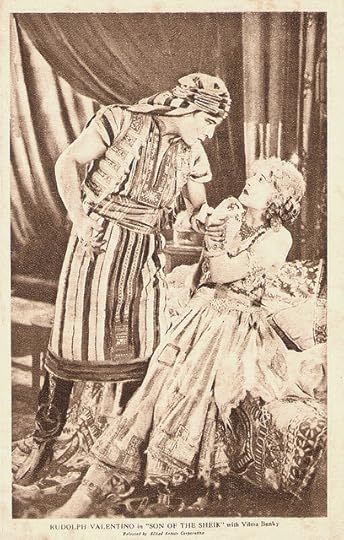
French postcard in a series by Shampoing Butywave. Photo: Allied Artists. Publicity still for The Son of the Sheik (1926), with Rudolph Valentino.
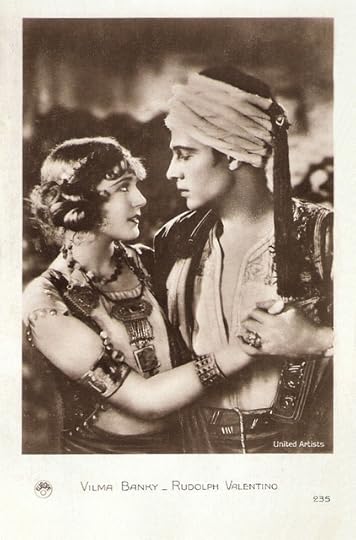
French postcard by Europa, no. 235. Photo: United Artists. Publicity still for The Son of the Sheik (1926), with Rudolph Valentino.
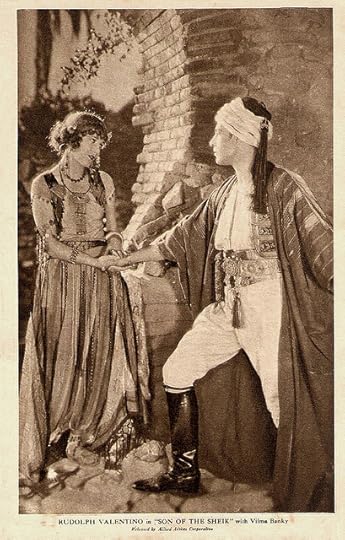
French postcard in a series by Shampoing Butywave. Photo: Allied Artists. Publicity still for The Son of the Sheik (1926), with Rudolph Valentino.
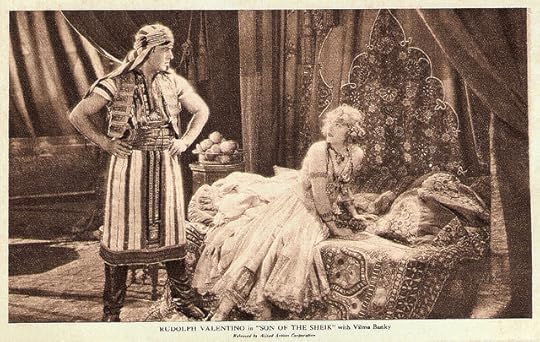
French postcard in a series by Shampoing Butywave. Photo: Allied Artists. Publicity still for The Son of the Sheik (1926), with Rudolph Valentino.
Extravagant Wedding
In 1927 Vilma Bánky married another star, Rod La Rocque, during an extravagant wedding, paid by Sam Goldwyn. Cecil B. DeMille was best man and the ushers included Ronald Colman and Harold Lloyd.
In 1928, Bánky participated in the first public demonstration of the way films could be transmitted over telephone wires. Film of her arrival by train in Chicago was shown at a newsreel theatre in New York nine hours later; the process was hailed as a technological breakthrough.
It is commonly believed that her thick Hungarian accent cut her career short with the advent of sound, however she also began losing interest in films and wanted to settle down with her new husband. Her first talking movie was This Is Heaven (Alfred Santell, 1929). It proved to be an awful experience for the almost inaudible Hungarian actress. A Lady To Love (Victor Sjöström, 1930) with Edward G. Robinson would be Bánky's final American film and her second attempt at a talkie.
According to IMDb reviewer drednm "it's a very good film indeed. (...) I was struck throughout this film at what a nice voice she had and how much her accent resembled that of Greta Garbo in Anna Christie that same year.". She also made an alternate-language version in German, Die Sehnsucht jeder Frau/Every Woman's Desire (Victor Sjöström, 1930).
Bánky went with Rod La Rocque to Germany to make a final film, Der Rebell/The Rebel (Edwin H. Knopf, Luis Trenker, 1932), starring Luis Trenker . Vilma remained with Rod till his death in 1969. Her post Hollywood years were spent selling real estate with her husband and playing golf, her favourite sport.
In 1981, Bánky established an educational fund called the Banky - La Rocque Foundation, which is still in operation. Vilma Bánky died in 1991, from cardiopulmonary failure, aged 90. Today, of her twenty-four films, seven exist in their entirety and three only in fragments.
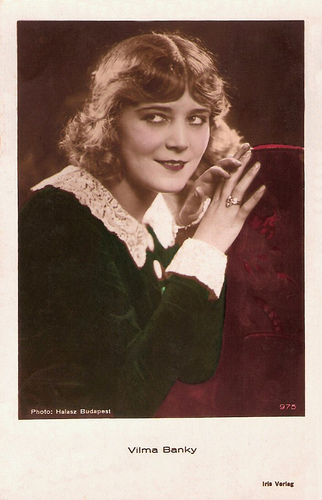
Austrian postcard by Iris Verlag, no. 975. Photo: Halasz, Budapest.
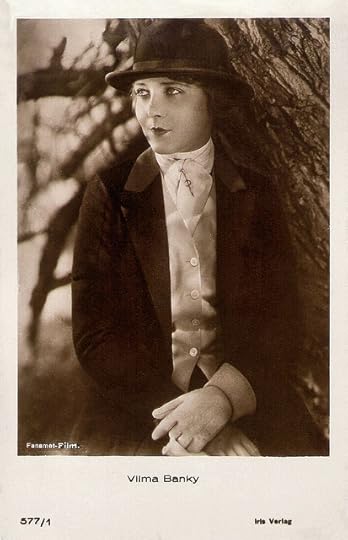
Austrian postcard by Iris Verlag, no. 577/1. Photo: Fanamet Film.
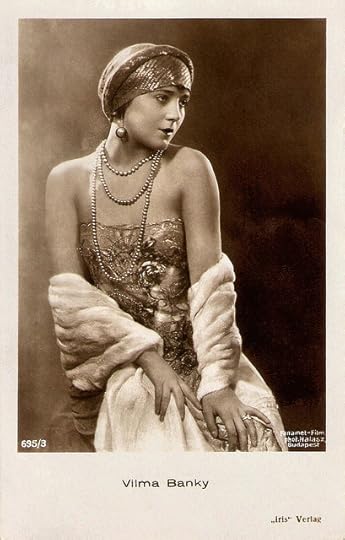
Austrian postcard by Iris Verlag, no. 695/3. Photo: Halasz, Budapest / Fanamet-Film.
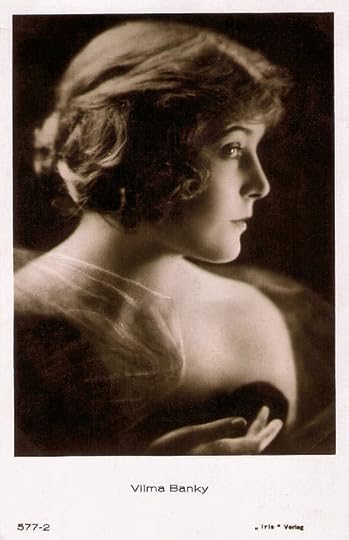
Austrian postcard by Iris Verlag, no. 577-2. Sent by mail in Serbia in 1930.
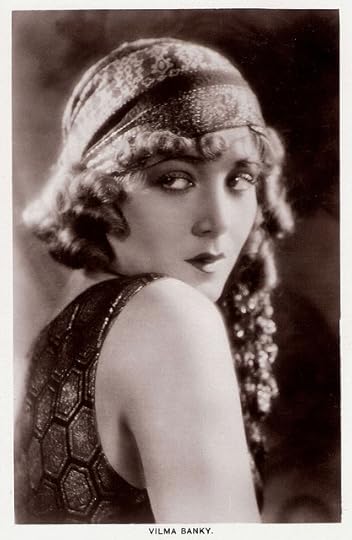
British postcard by Real Photograph in the Picturegoer series, no. 272.
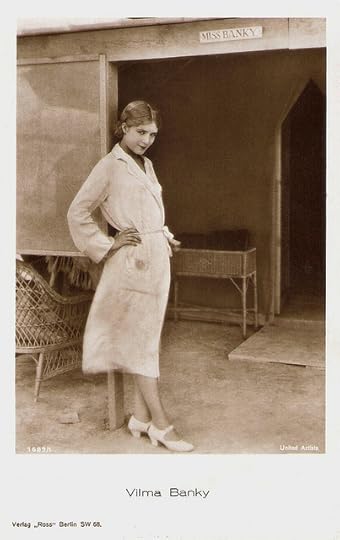
German postcard by Ross Verlag, no. 1689/1, 1927-1928. Photo: United Artists.
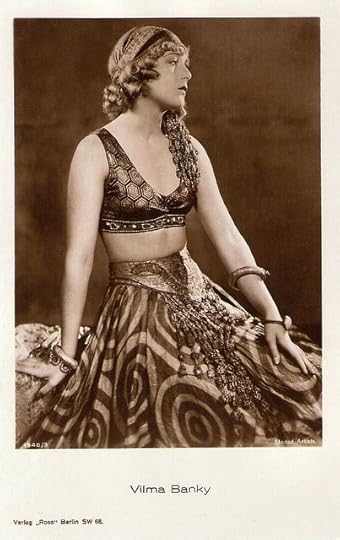
German postcard by Ross Verlag, no. 1540/3, 1927-1928. Photo: United Artists.
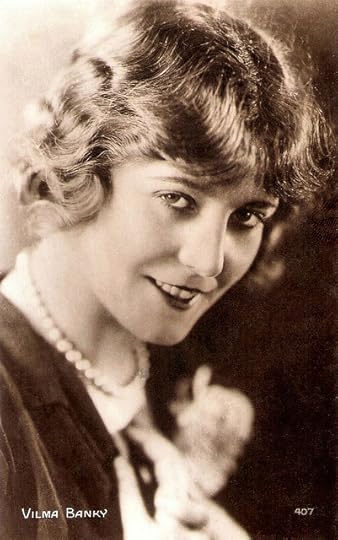
French postcard by Cinémagazine-Edition, Paris, no. 407.
Vilma Banky and Rudolph Valentino in a scene from The Eagle (1925). Source: (YouTube).
Sources: (IMDb), Thomas Staedeli (Cyranos), New York Times, Wikipedia, and .

British postcard in the 'Famous Cinema Star' series by J. Beagles & Co, LTD., London, no. 235 G. Photo: Allied Artists Pictures.
Blonde And Violet-Eyed
Vilma Bánky was born Vilma Konsics Bánky to János Konsics Bánky and Katalin Ulbert in Nagydorog, Austria-Hungary, in 1901. (Although reference books give dates ranging from 1898 to 1903).
Her father was a bureau chief under Franz Joseph's Austro-Hungarian Empire. Shortly after her birth, her father was transferred to Budapest, and the family relocated. She had two siblings - an older brother, Gyula (who would later go on to work in Berlin as a writer and cinematographer), and a younger sister, Gisella.
After graduation from secondary school, Bánky took courses to work as a stenographer, but then she was offered a role in a film. Her debut was in the now lost German film Im Letzten Augenblick/The Last Moment (Carl Boese, 1919).
The violet-eyed, blonde beauty was soon asked for Hungarian, Austrian, and French films. To her European productions belong Galathea (Béla Balogh, 1921), A Halott szerelma/The Eye of the Death (Carl Boese, 1922), Das Bildnis/The Picture (Jacques Feyder, 1923), Das verbotene Land/The Forbidden Country (Friedrich Feher, 1924), and Soll man heiraten?/Do You Have to Marry? (Manfred Noa, 1925).

French postcard by Editions Cinémagazine, no. 428. Photo: Vilma Banky in The Winning of Barbara Worth (Henry King, 1926), also with Ronald Colman and a young Gary Cooper, who debuted in this film.

French postcard by Editions Cinémagazine, no. 433, with Ronald Colman .

German postcard by Ross Verlag, no. 3375/3, 1928-1929. Photo: United Artists. Publicity still for Two Lovers (Fred Niblo, 1928), with Ronald Colman .

German postcard by Ross Verlag, no. 3375/1, 1928-1929. Photo: United Artists. Publicity still for Two Lovers (Fred Niblo, 1928), with Ronald Colman .

German postcard by Ross Verlag, no. 2082/3, 1927-1928. Photo: United Artists, with Ronald Colman .
The Hungarian Rhapsody
On a trip to Budapest in 1925, Hollywood film producer Samuel Goldwyn discovered and signed Vilma Bánky to a contract. Both her mother and father were vehemently against Bánky's acting career as was her fiancé.
Nonetheless she left for the United States in March 1925, arriving to a great deal of fanfare. She was hailed as ‘The Hungarian Rhapsody’.
Bánky was an immediate hit with American audiences with her first American film, The Dark Angel (George Fitzmaurice, 1925). The New York Times review praised her acting and called her "so exquisite that one is not in the least surprised that she is never forgotten" by her co-star.
This would be the first of five fantastic love stories in which she co-starred with Ronald Colman , including the very popular The Winning of Barbara Worth (Henry King, 1926).
Opposite Rudolph Valentino, she appeared as the daughter of a Russian aristocrat in The Eagle (Clarence Brown, 1925), and as an Arab dancer in his last film The Son of the Sheik (George Fitzmaurice, 1926).

French postcard in a series by Shampoing Butywave. Photo: Allied Artists. Publicity still for The Son of the Sheik (1926), with Rudolph Valentino. The woman portrayed is not Vilma Banky, but Agnes Ayres.

French postcard in a series by Shampoing Butywave. Photo: Allied Artists. Publicity still for The Son of the Sheik (1926), with Rudolph Valentino.

French postcard by Europa, no. 235. Photo: United Artists. Publicity still for The Son of the Sheik (1926), with Rudolph Valentino.

French postcard in a series by Shampoing Butywave. Photo: Allied Artists. Publicity still for The Son of the Sheik (1926), with Rudolph Valentino.

French postcard in a series by Shampoing Butywave. Photo: Allied Artists. Publicity still for The Son of the Sheik (1926), with Rudolph Valentino.
Extravagant Wedding
In 1927 Vilma Bánky married another star, Rod La Rocque, during an extravagant wedding, paid by Sam Goldwyn. Cecil B. DeMille was best man and the ushers included Ronald Colman and Harold Lloyd.
In 1928, Bánky participated in the first public demonstration of the way films could be transmitted over telephone wires. Film of her arrival by train in Chicago was shown at a newsreel theatre in New York nine hours later; the process was hailed as a technological breakthrough.
It is commonly believed that her thick Hungarian accent cut her career short with the advent of sound, however she also began losing interest in films and wanted to settle down with her new husband. Her first talking movie was This Is Heaven (Alfred Santell, 1929). It proved to be an awful experience for the almost inaudible Hungarian actress. A Lady To Love (Victor Sjöström, 1930) with Edward G. Robinson would be Bánky's final American film and her second attempt at a talkie.
According to IMDb reviewer drednm "it's a very good film indeed. (...) I was struck throughout this film at what a nice voice she had and how much her accent resembled that of Greta Garbo in Anna Christie that same year.". She also made an alternate-language version in German, Die Sehnsucht jeder Frau/Every Woman's Desire (Victor Sjöström, 1930).
Bánky went with Rod La Rocque to Germany to make a final film, Der Rebell/The Rebel (Edwin H. Knopf, Luis Trenker, 1932), starring Luis Trenker . Vilma remained with Rod till his death in 1969. Her post Hollywood years were spent selling real estate with her husband and playing golf, her favourite sport.
In 1981, Bánky established an educational fund called the Banky - La Rocque Foundation, which is still in operation. Vilma Bánky died in 1991, from cardiopulmonary failure, aged 90. Today, of her twenty-four films, seven exist in their entirety and three only in fragments.

Austrian postcard by Iris Verlag, no. 975. Photo: Halasz, Budapest.

Austrian postcard by Iris Verlag, no. 577/1. Photo: Fanamet Film.

Austrian postcard by Iris Verlag, no. 695/3. Photo: Halasz, Budapest / Fanamet-Film.

Austrian postcard by Iris Verlag, no. 577-2. Sent by mail in Serbia in 1930.

British postcard by Real Photograph in the Picturegoer series, no. 272.

German postcard by Ross Verlag, no. 1689/1, 1927-1928. Photo: United Artists.

German postcard by Ross Verlag, no. 1540/3, 1927-1928. Photo: United Artists.

French postcard by Cinémagazine-Edition, Paris, no. 407.
Vilma Banky and Rudolph Valentino in a scene from The Eagle (1925). Source: (YouTube).
Sources: (IMDb), Thomas Staedeli (Cyranos), New York Times, Wikipedia, and .
Published on September 03, 2013 23:00
September 2, 2013
Imported from the USA: Lex Barker
We continue our new series 'Imported from the USA' with Lex Barker. After a Hollywood career as Tarzan and Mr Lana Turner, Barker moved to Europe. Here he worked with Federico Fellini and later became Old Shatterhand in the popular Karl May film series.
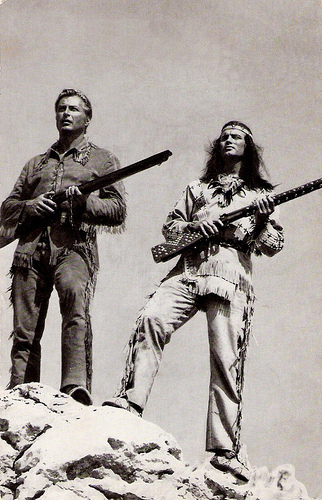 Vintage Dutch postcard. With
Pierre Brice
at right.
Vintage Dutch postcard. With
Pierre Brice
at right.
Old Shatterhand “Lake Of Terror! Battle Of Vengeance!” was the tagline of the German-Yugoslavian-French co-production Der Schatz im Silbersee/Treasure of Silver Lake (Harald Reinl, 1962), the first and the best of the European Westerns based on the novels by Karl May.
In 1962-1963 Der Schatz im Silbersee had over 3 million visitors and today it is still an entertaining film with likable characters like the Apache chief Winnetou ( Pierre Brice ) and his blood brother, the frontiersman Old Shatterhand, played by Lex Barker. Der Schatz im Silbersee made both into superstars in Germany.
Like his co-star and good friend Pierre Brice , Barker later started a singing career and released several records.
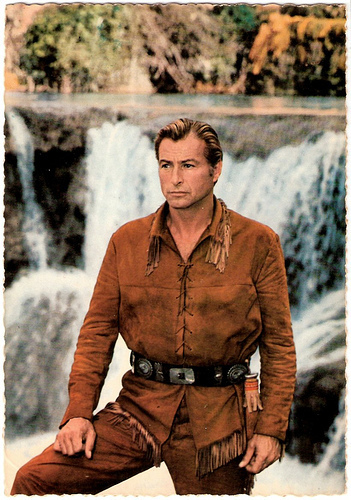 German postcard by Kruger. Photo:
Bernard of Hollywood
(Bruno Bernard) / CCC-Produktion. Publicity Still for Old Shatterhand (Hugo Fregonese, 1964).
German postcard by Kruger. Photo:
Bernard of Hollywood
(Bruno Bernard) / CCC-Produktion. Publicity Still for Old Shatterhand (Hugo Fregonese, 1964).
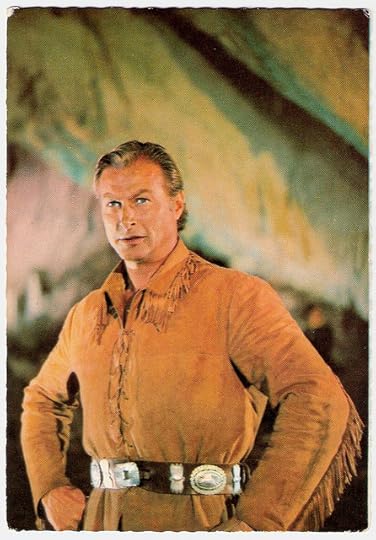 German postcard, no. E 82. Photo: Constantin. Publicity still for Der Schatz im Silbersee/Treasure of Silver Lake (1962).
German postcard, no. E 82. Photo: Constantin. Publicity still for Der Schatz im Silbersee/Treasure of Silver Lake (1962).
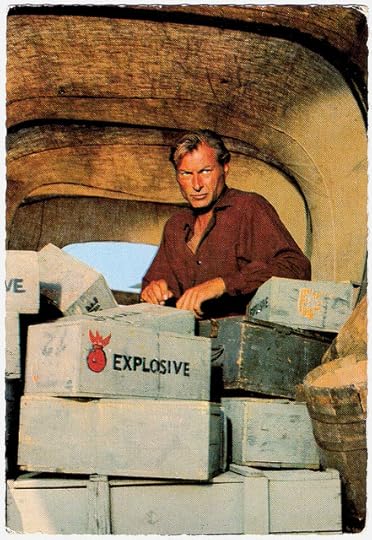 German postcard, no. E 9. Photo: Constantin. Still from Winnetou - 1. Teil/Apache Gold (Harald Reinl, 1963). Caption: "Old Shatterhand puts a rat in the ammunition and saves himself with a bold leap onto the horse. The remaining car, surrounded by Kiowas, explodes."
German postcard, no. E 9. Photo: Constantin. Still from Winnetou - 1. Teil/Apache Gold (Harald Reinl, 1963). Caption: "Old Shatterhand puts a rat in the ammunition and saves himself with a bold leap onto the horse. The remaining car, surrounded by Kiowas, explodes."
Disowned By His Family Lex Barker was born Alexander Crichlow Barker, Jr. into a prominent and wealthy New York family in 1919 He was the second child of Alexander Crichlow Barker, Sr., a Canadian-born building contractor and his American wife, the former Marion Thornton Beals. His father later worked as a stockbroker. Barker took time off from being a high-profile playboy to attend Princeton University, but dropped out in order to join a theatrical stock company, much to the chagrin of his family.
He made it to Broadway once, in a small role in a short run of William Shakepeare's The Merry Wives of Windsor in 1938. He also had a small role in Orson Welles's disastrous Five Kings, which met with so many problems in Boston and Philadelphia that it never made it into New York. Barker reportedly was spotted by scouts from Twentieth Century Fox and offered a film contract in 1939, but could not convince his parents to sign it (he was underage). Disowned by his family for his choice of an acting career, he worked in a steel mill and studied engineering at night. In February 1941, ten months before the attack on Pearl Harbor, Barker left his fledgling acting career and enlisted in the US Army. He rose to the rank of major during the war. He was wounded in action fighting in Sicily.
Back in the United States, Barker recuperated at an Arkansas military hospital, then upon his discharge from service, travelled to Los Angeles. Within a short time, he landed a small role in his first film, Doll Face (Lewis Seiler, 1945) starring Vivian Blaine. A string of small roles followed, the best of which was as Emmett Dalton in the Western Return of the Bad Men (Ray Enright, 1948). Barker then found the role that would bring him fame.
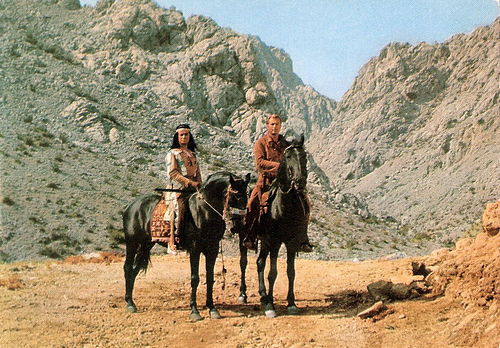 Dutch postcard by Facet Publishers, Lunteren, no. 4. Photo: Rank Film Distributors (Holland) N.V. Publicity still from Der Schatz im Silbersee (1963) with
Pierre Brice
.
Dutch postcard by Facet Publishers, Lunteren, no. 4. Photo: Rank Film Distributors (Holland) N.V. Publicity still from Der Schatz im Silbersee (1963) with
Pierre Brice
.
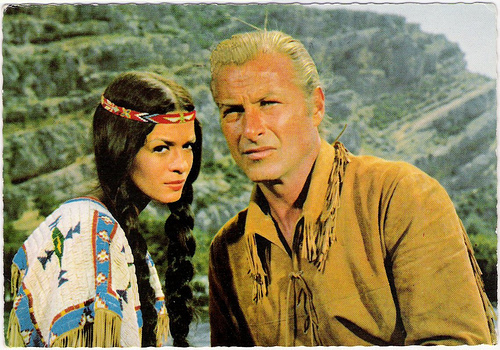 German postcard, no. E 30. With
Marie Versini
.
German postcard, no. E 30. With
Marie Versini
.
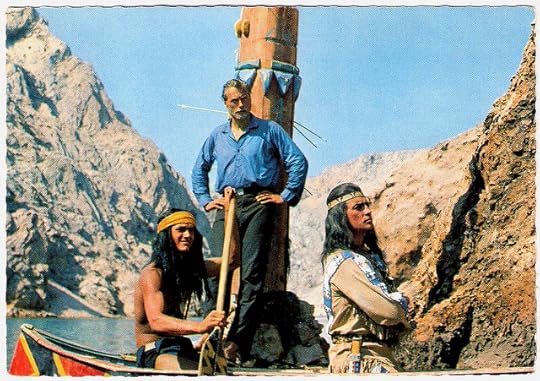 German postcard, no. E 26. Photo: Constantin. Still from Winnetou I (1963) with
Pierre Brice
at right. Caption: "Old Shatterhand, an Kräften und List dem Apachen-Häuptling überlegen, besiegt diesen, doch schont dessen Leben. Das Gottesurteil hat gesprochen. Old Shatterhand und seine Getreuen sind frei. (Old Shatterhand, superior in strength and cunning to the Apache chieftain, defeats him, but spares his life. The judgment of God has spoken. Old Shatterhand and his followers are free.)"
German postcard, no. E 26. Photo: Constantin. Still from Winnetou I (1963) with
Pierre Brice
at right. Caption: "Old Shatterhand, an Kräften und List dem Apachen-Häuptling überlegen, besiegt diesen, doch schont dessen Leben. Das Gottesurteil hat gesprochen. Old Shatterhand und seine Getreuen sind frei. (Old Shatterhand, superior in strength and cunning to the Apache chieftain, defeats him, but spares his life. The judgment of God has spoken. Old Shatterhand and his followers are free.)"
Ape-Man In Tarzan's Magic Fountain (Lee Sholem, 1949), Lex Barker became the tenth official Tarzan of the cinema. He replaced Johnny Weissmuller. His blond, stunningly handsome, and intelligent appearance, as well as his athletic frame, helped make him popular in the role as Edgar Rice Burroughs’ ape-man. Barker made only five Tarzan films produced by Sol Lesser between 1949 and 1953, but he remains one of the actors best known for the role.
His stardom as Tarzan led him to a variety of heroic roles in other films, primarily Westerns, and one interesting (and quite non-heroic) part in a World War II film, Away All Boats (Joseph Pevney, 1956) starring Jeff Chandler. Barker's film career began to stall; the rise of television had erased many roles for the handsome leading man. In 1957, he moved to Europe. Via England, he made his way to Italy where he was very much at home in the wave of Peplums. He also filmed in Spain and France. In Italy, he had a short but prestigious role as Anita Ekberg 's fiancé in Federico Fellini's La Dolce Vita (1960).
But Barker had his greatest success in Germany. There he starred in two films based on the Doctor Mabuse stories (formerly filmed by Fritz Lang). As the hunter of the notorious Dr. Mabuse he played F.B.I. man Joe Como in the two black and white crime thrillers Im Stahlnetz des Dr. Mabuse/Return Of Dr. Mabuse (Harald Reinl, 1961) and Die Unsichtbare Krallen des Dr. Mabuse/Invisible Dr. Mabuse (Harald Reinl, 1962). He also starred in the drama Frauenarzt Dr. Sibelius/Dr. Sibelius (Rudolf Jugert, 1962) and the comedy Frühstück im Doppelbett/Breakfast in Bed (Axel von Ambesser, 1963) with O.W. Fischer . His most successful film was the Karl May adaptation Der Schatz im Silbersee/Treasure of Silver Lake (Harald Reinl, 1962) with Pierre Brice as Winnetou.
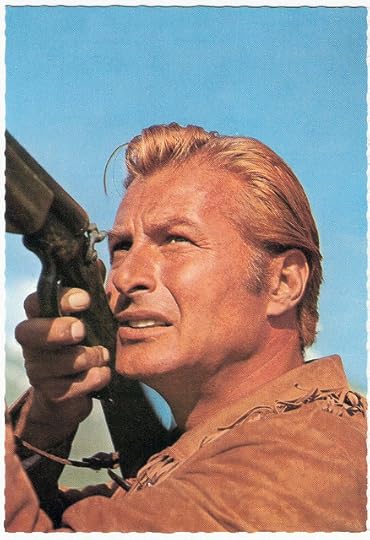 German postcard, no. E 79. Photo: Constantin. Publicity still for Der Schatz im Silbersee (1962).
German postcard, no. E 79. Photo: Constantin. Publicity still for Der Schatz im Silbersee (1962).
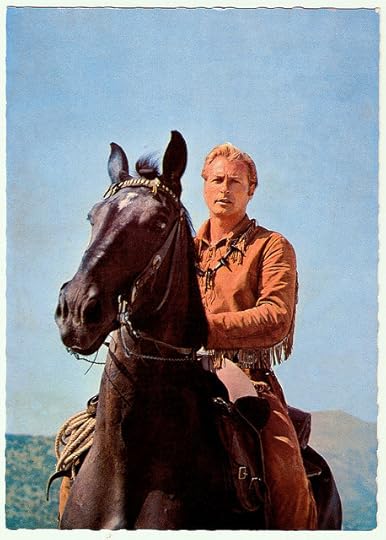 German postcard, no. E 53. Photo: Constantin. Publicity still for Der Schatz im Silbersee (1962).
German postcard, no. E 53. Photo: Constantin. Publicity still for Der Schatz im Silbersee (1962).
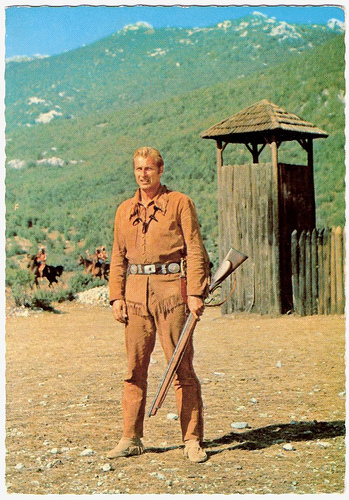 German postcard, no. E 57. Photo: Constantin. Publicity still for Der Schatz im Silbersee (1962).
German postcard, no. E 57. Photo: Constantin. Publicity still for Der Schatz im Silbersee (1962).
James Bond Rip-offs In the following years, Lex Barker played in 12 more films based on novels by Karl May in which he played such well-known May characters as Old Shatterhand, Kara Ben Nemsi, and Dr. Karl Sternau. While American audiences forgot about him, his popularity in Europe quickly soared above the popularity of stars like John Wayne. In 1966, Barker was awarded the Bambi Award as Best Foreign Actor in Germany. He even recorded a single, in German, with Martin Böttcher, the composer of some of the soundtracks of the Karl May films: Ich bin morgen auf dem Weg zu dir (I'll be on the way to you tomorrow) and Mädchen in Samt und Seide (Girl in Silk and Velvet).
Barker returned to the United States occasionally and made a handful of guest appearances on American television episodes. But Europe, and especially Germany, was his professional home for the remainder of his life. He showed up in a handful of James Bond rip-offs. In 1967, he appeared with Shirley MacLaine in one part of an American seven-part film Woman Times Seven (1967), directed by Vittorio de Sica .
Lex Barker died of a heart attack in 1973 in New York. He was 54. Barker had been married five times. His wives were Constance Rhodes Thurlow (1942-1950), actress Arlene Dahl (1951-1952), actress Lana Turner (1953-1957), Swiss actress Irene Labhardt (1957-1962) and Carmen Cervera (1965-1972), a former Miss Spain. He left behind two sons and one daughter. One of his sons is actor Christopher Barker, from his marriage to Irene Labhart.
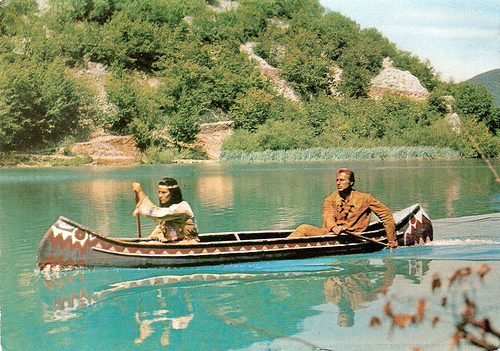
Dutch postcard by Gebr. Spanjersberg N.V., Rotterdam / Edition Facet Publishers. Photo: Rank Film Publishers (Holland) N.V. Publicity Still for Der Schatz im Silbersee (1962).
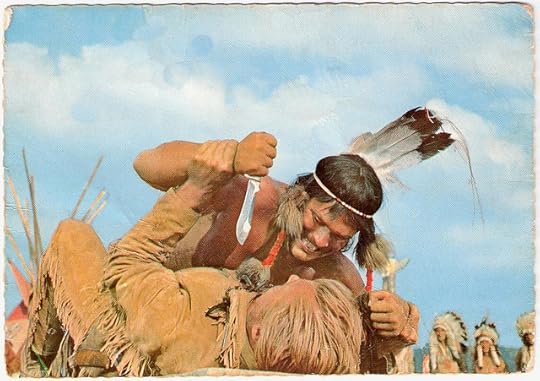
German postcard, no. E 72. Photo: Constantin. Publicity Still for Der Schatz im Silbersee (1962).
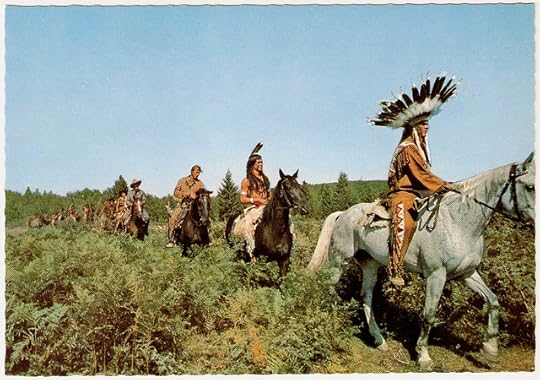
German postcard, no. ED 66. Photo: Constantin. Publicity still for Der Schatz in Silbersee (1962).
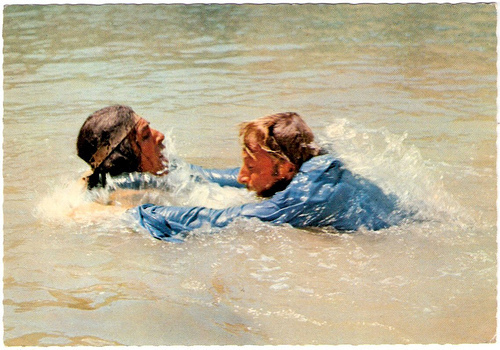
German postcard, no. E 25. Photo: Constantin. Publicity still for Winnetou I (1963) with Mavid Popovic. Caption: "In the water there is a bitter fight between Old Shatterhand and Winnetou's father, the chief of the Apaches."
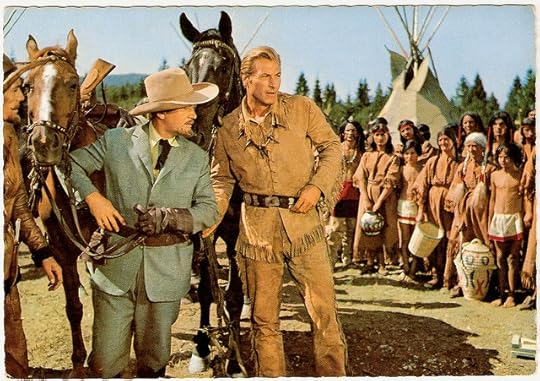
German postcard, no. E 68. Photo: Constantin. Publicity still for Der Schatz in Silbersee (1962) with Jan Sid.
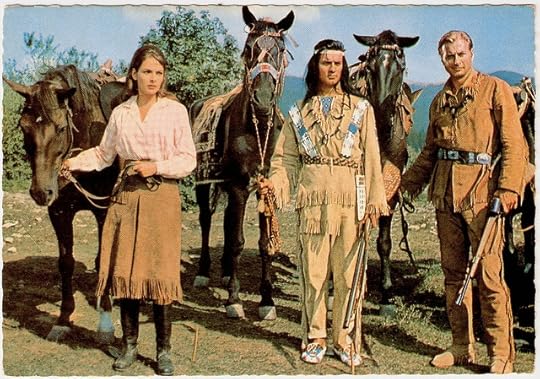
German postcard, no. ED 64. Photo: Constantin. Publicity still for Der Schatz in Silbersee (1962) with Karin Dor and Pierre Brice .
This was the third episode of 'Imported from the USA'. The first two episodes were dedicated to Jayne Mansfield and Josephine Baker.
Sources: Hal Erickson (AllMovie), Lex Barker Official Site, Brian J. Walker (Brian's Drive-In Theater), Wikipedia and
 Vintage Dutch postcard. With
Pierre Brice
at right.
Vintage Dutch postcard. With
Pierre Brice
at right.Old Shatterhand “Lake Of Terror! Battle Of Vengeance!” was the tagline of the German-Yugoslavian-French co-production Der Schatz im Silbersee/Treasure of Silver Lake (Harald Reinl, 1962), the first and the best of the European Westerns based on the novels by Karl May.
In 1962-1963 Der Schatz im Silbersee had over 3 million visitors and today it is still an entertaining film with likable characters like the Apache chief Winnetou ( Pierre Brice ) and his blood brother, the frontiersman Old Shatterhand, played by Lex Barker. Der Schatz im Silbersee made both into superstars in Germany.
Like his co-star and good friend Pierre Brice , Barker later started a singing career and released several records.
 German postcard by Kruger. Photo:
Bernard of Hollywood
(Bruno Bernard) / CCC-Produktion. Publicity Still for Old Shatterhand (Hugo Fregonese, 1964).
German postcard by Kruger. Photo:
Bernard of Hollywood
(Bruno Bernard) / CCC-Produktion. Publicity Still for Old Shatterhand (Hugo Fregonese, 1964). German postcard, no. E 82. Photo: Constantin. Publicity still for Der Schatz im Silbersee/Treasure of Silver Lake (1962).
German postcard, no. E 82. Photo: Constantin. Publicity still for Der Schatz im Silbersee/Treasure of Silver Lake (1962). German postcard, no. E 9. Photo: Constantin. Still from Winnetou - 1. Teil/Apache Gold (Harald Reinl, 1963). Caption: "Old Shatterhand puts a rat in the ammunition and saves himself with a bold leap onto the horse. The remaining car, surrounded by Kiowas, explodes."
German postcard, no. E 9. Photo: Constantin. Still from Winnetou - 1. Teil/Apache Gold (Harald Reinl, 1963). Caption: "Old Shatterhand puts a rat in the ammunition and saves himself with a bold leap onto the horse. The remaining car, surrounded by Kiowas, explodes."Disowned By His Family Lex Barker was born Alexander Crichlow Barker, Jr. into a prominent and wealthy New York family in 1919 He was the second child of Alexander Crichlow Barker, Sr., a Canadian-born building contractor and his American wife, the former Marion Thornton Beals. His father later worked as a stockbroker. Barker took time off from being a high-profile playboy to attend Princeton University, but dropped out in order to join a theatrical stock company, much to the chagrin of his family.
He made it to Broadway once, in a small role in a short run of William Shakepeare's The Merry Wives of Windsor in 1938. He also had a small role in Orson Welles's disastrous Five Kings, which met with so many problems in Boston and Philadelphia that it never made it into New York. Barker reportedly was spotted by scouts from Twentieth Century Fox and offered a film contract in 1939, but could not convince his parents to sign it (he was underage). Disowned by his family for his choice of an acting career, he worked in a steel mill and studied engineering at night. In February 1941, ten months before the attack on Pearl Harbor, Barker left his fledgling acting career and enlisted in the US Army. He rose to the rank of major during the war. He was wounded in action fighting in Sicily.
Back in the United States, Barker recuperated at an Arkansas military hospital, then upon his discharge from service, travelled to Los Angeles. Within a short time, he landed a small role in his first film, Doll Face (Lewis Seiler, 1945) starring Vivian Blaine. A string of small roles followed, the best of which was as Emmett Dalton in the Western Return of the Bad Men (Ray Enright, 1948). Barker then found the role that would bring him fame.
 Dutch postcard by Facet Publishers, Lunteren, no. 4. Photo: Rank Film Distributors (Holland) N.V. Publicity still from Der Schatz im Silbersee (1963) with
Pierre Brice
.
Dutch postcard by Facet Publishers, Lunteren, no. 4. Photo: Rank Film Distributors (Holland) N.V. Publicity still from Der Schatz im Silbersee (1963) with
Pierre Brice
. German postcard, no. E 30. With
Marie Versini
.
German postcard, no. E 30. With
Marie Versini
. German postcard, no. E 26. Photo: Constantin. Still from Winnetou I (1963) with
Pierre Brice
at right. Caption: "Old Shatterhand, an Kräften und List dem Apachen-Häuptling überlegen, besiegt diesen, doch schont dessen Leben. Das Gottesurteil hat gesprochen. Old Shatterhand und seine Getreuen sind frei. (Old Shatterhand, superior in strength and cunning to the Apache chieftain, defeats him, but spares his life. The judgment of God has spoken. Old Shatterhand and his followers are free.)"
German postcard, no. E 26. Photo: Constantin. Still from Winnetou I (1963) with
Pierre Brice
at right. Caption: "Old Shatterhand, an Kräften und List dem Apachen-Häuptling überlegen, besiegt diesen, doch schont dessen Leben. Das Gottesurteil hat gesprochen. Old Shatterhand und seine Getreuen sind frei. (Old Shatterhand, superior in strength and cunning to the Apache chieftain, defeats him, but spares his life. The judgment of God has spoken. Old Shatterhand and his followers are free.)" Ape-Man In Tarzan's Magic Fountain (Lee Sholem, 1949), Lex Barker became the tenth official Tarzan of the cinema. He replaced Johnny Weissmuller. His blond, stunningly handsome, and intelligent appearance, as well as his athletic frame, helped make him popular in the role as Edgar Rice Burroughs’ ape-man. Barker made only five Tarzan films produced by Sol Lesser between 1949 and 1953, but he remains one of the actors best known for the role.
His stardom as Tarzan led him to a variety of heroic roles in other films, primarily Westerns, and one interesting (and quite non-heroic) part in a World War II film, Away All Boats (Joseph Pevney, 1956) starring Jeff Chandler. Barker's film career began to stall; the rise of television had erased many roles for the handsome leading man. In 1957, he moved to Europe. Via England, he made his way to Italy where he was very much at home in the wave of Peplums. He also filmed in Spain and France. In Italy, he had a short but prestigious role as Anita Ekberg 's fiancé in Federico Fellini's La Dolce Vita (1960).
But Barker had his greatest success in Germany. There he starred in two films based on the Doctor Mabuse stories (formerly filmed by Fritz Lang). As the hunter of the notorious Dr. Mabuse he played F.B.I. man Joe Como in the two black and white crime thrillers Im Stahlnetz des Dr. Mabuse/Return Of Dr. Mabuse (Harald Reinl, 1961) and Die Unsichtbare Krallen des Dr. Mabuse/Invisible Dr. Mabuse (Harald Reinl, 1962). He also starred in the drama Frauenarzt Dr. Sibelius/Dr. Sibelius (Rudolf Jugert, 1962) and the comedy Frühstück im Doppelbett/Breakfast in Bed (Axel von Ambesser, 1963) with O.W. Fischer . His most successful film was the Karl May adaptation Der Schatz im Silbersee/Treasure of Silver Lake (Harald Reinl, 1962) with Pierre Brice as Winnetou.
 German postcard, no. E 79. Photo: Constantin. Publicity still for Der Schatz im Silbersee (1962).
German postcard, no. E 79. Photo: Constantin. Publicity still for Der Schatz im Silbersee (1962). German postcard, no. E 53. Photo: Constantin. Publicity still for Der Schatz im Silbersee (1962).
German postcard, no. E 53. Photo: Constantin. Publicity still for Der Schatz im Silbersee (1962). German postcard, no. E 57. Photo: Constantin. Publicity still for Der Schatz im Silbersee (1962).
German postcard, no. E 57. Photo: Constantin. Publicity still for Der Schatz im Silbersee (1962).James Bond Rip-offs In the following years, Lex Barker played in 12 more films based on novels by Karl May in which he played such well-known May characters as Old Shatterhand, Kara Ben Nemsi, and Dr. Karl Sternau. While American audiences forgot about him, his popularity in Europe quickly soared above the popularity of stars like John Wayne. In 1966, Barker was awarded the Bambi Award as Best Foreign Actor in Germany. He even recorded a single, in German, with Martin Böttcher, the composer of some of the soundtracks of the Karl May films: Ich bin morgen auf dem Weg zu dir (I'll be on the way to you tomorrow) and Mädchen in Samt und Seide (Girl in Silk and Velvet).
Barker returned to the United States occasionally and made a handful of guest appearances on American television episodes. But Europe, and especially Germany, was his professional home for the remainder of his life. He showed up in a handful of James Bond rip-offs. In 1967, he appeared with Shirley MacLaine in one part of an American seven-part film Woman Times Seven (1967), directed by Vittorio de Sica .
Lex Barker died of a heart attack in 1973 in New York. He was 54. Barker had been married five times. His wives were Constance Rhodes Thurlow (1942-1950), actress Arlene Dahl (1951-1952), actress Lana Turner (1953-1957), Swiss actress Irene Labhardt (1957-1962) and Carmen Cervera (1965-1972), a former Miss Spain. He left behind two sons and one daughter. One of his sons is actor Christopher Barker, from his marriage to Irene Labhart.

Dutch postcard by Gebr. Spanjersberg N.V., Rotterdam / Edition Facet Publishers. Photo: Rank Film Publishers (Holland) N.V. Publicity Still for Der Schatz im Silbersee (1962).

German postcard, no. E 72. Photo: Constantin. Publicity Still for Der Schatz im Silbersee (1962).

German postcard, no. ED 66. Photo: Constantin. Publicity still for Der Schatz in Silbersee (1962).

German postcard, no. E 25. Photo: Constantin. Publicity still for Winnetou I (1963) with Mavid Popovic. Caption: "In the water there is a bitter fight between Old Shatterhand and Winnetou's father, the chief of the Apaches."

German postcard, no. E 68. Photo: Constantin. Publicity still for Der Schatz in Silbersee (1962) with Jan Sid.

German postcard, no. ED 64. Photo: Constantin. Publicity still for Der Schatz in Silbersee (1962) with Karin Dor and Pierre Brice .
This was the third episode of 'Imported from the USA'. The first two episodes were dedicated to Jayne Mansfield and Josephine Baker.
Sources: Hal Erickson (AllMovie), Lex Barker Official Site, Brian J. Walker (Brian's Drive-In Theater), Wikipedia and
Published on September 02, 2013 23:00
September 1, 2013
Marcel Lévesque
French actor and scriptwriter Marcel Lévesque (1877-1962) excelled in silent and sound comedies but he also played memorable parts in the crime serials by Louis Feuillade and in Jean Renoir’s Le crime de M. Lange.
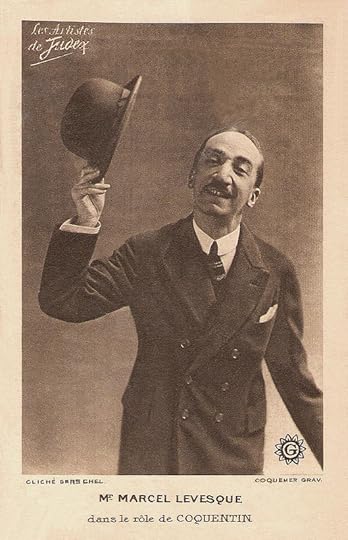
French postcard by Coquemer Gravures, Paris. Photo: Gerschel / Gaumont. Still for La nouvelle mission de Judex (Louis Feuillade, 1917-1918).
Countless Witty Characters
Joseph Marcel Lévesque was born in the Montmartre district of Paris in 1877.
He entered the Paris Conservatory but left quickly enough to make his stage debut in 1896. In 1900, he joined the cast of the Théâtre de l’Athénée, where for five years he forged a reputation as an actor who easily changed from comedy to drama.
Afterwards he also played at the Odeon and the Palais Royal. Like so many other stage performers, the film world discovered his talent, as of 1909. Lévesque started to appear in various shorts, but little is known about this.
He did act with Jean Dax and Nelly Cormon in the short historical film L’arrestation de la Duchesse de Berry/The arrest of the Duchess of Berry (André Calmettes, 1910) for Films d'Art (Pathé).
In 1913, he joined Gaumont where he met actor-director Léonce Perret for whom he wrote La belle-mère/The Stepmother (1913) with Suzanne Le Bret, followed by Léonce et Poupette (1913), which he scripted as well and in which he played Léonce’s man servant.
He followed this with the lead in L’illustre Mâchefer/The Illustrious Clinker (1913), directed by Louis Feuillade, who would become his regular director between 1913 and 1918 and which whom he acted in almost 30 films plus some serials.
Feuillade would have him play countless witty characters in the comedy series La vie drôle/Funny Life.
Meanwhile, Marcel Lévesque had tried his luck at film direction at Gaumont with La pintade et le dindon/Guinea pig and fowl (1915) with Madeleine Guitty as his partner.
Feuillade also used him in more mature roles for his crime serials Les Vampires/The Vampires (1915-1916) with the dangerous Musidora – Lévesque played Oscar Mazamette - and Judex (1916-1917).
In Judex he played the unpredictable Cocantin, a role he resumed in Feuillade’s sequel La nouvelle mission de Judex/The New Mission of Judex (1917-1918), again with René Cresté as the protagonist.
Lévesque also played in a parody of the crime serials, Le pied qui étreint (1916) by Jacques Feyder, with again Musidora, René Poyen (Bout de Zan) and André Roanne .
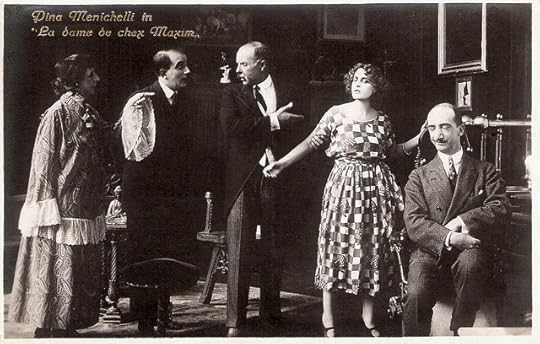
Italian postcard by Ed. G.B. Falci, Milano. Photo: publicity still for La dame de Chez Maxim's (Amleto Palermi, 1923) with Pina Menichelli .
Extraordinary, Subtle And Discreet Performance
Although Marcel Lévesque did not always have the lead in his films, his extraordinary, subtle and discreet performance made him steal the scenes in whichever film he acted in.
In 1918, producer Louis Nalpas engaged him for some years to be Serpentin in a burlesque series draped around his character and directed by Jean Durand, occasionally also by Alfred Machin.
Gaston Modot was often his co-actor here.
In 1919 Lévesque also played in the prestigious, two-part exotic drama La sultane de l’amour (René Le Somptier, Charles Burguet, 1919), starring France Dhélia .
In 1920 Marcel Lévesque went back to the theatre to act in Je t’aime (I love you), a new play by Sacha Guitry.
In the early 1920s Lévesque went to Italy to be the comical antagonist of Pina Menichelli in the Georges Feydeau comedies La dama de Chez Maxim's/La dame de chez Maxim’s (Amleto Palermi, 1923) and Occupati d'Amelia/Occupe-toi d’Amélie (Telemaco Ruggeri, 1924). These were Menichelli's last films before she married and retired from the screen.
He also played with Mario Bonnard in Il tacchino/The turkey (1924) and Théodore et Cie (1925) and with Palermi again in Florette e Patapon (1927) with Ossi Oswalda .
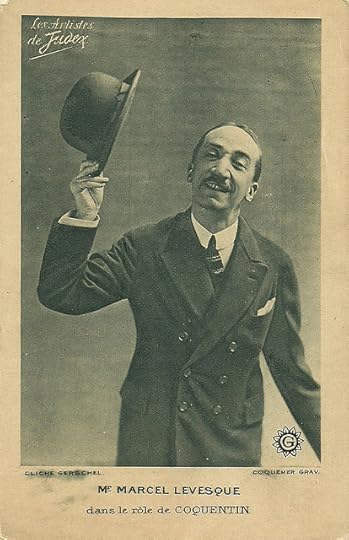
French postcard by Coquemer Gravures, Paris. Photo: Gerschel / Gaumont. Still for La nouvelle mission de Judex (Louis Feuillade, 1917-1918).
The Unforgettable, Authority Respecting Concierge
Unlike many other actors from the silent cinema, Marcel Lévesque’s career took a new turn with the advent of the talkies.
He became one of the most important supporting actors in early French sound cinema.
Lévesque played a pharmacist in love with Josseline Gaël in Jacques Tourneur’s drama Tout ça ne vaut pas l’amour/All this is not worth the love, 1931) starring Jean Gabin , and he played a collector of garters in L’affaire Coquelet/The Cockelet Case (Jean Gourguet, 1934).
But most of all he was the unforgettable, authority respecting concierge in Jean Renoir’s Le crime de Monsieur Lange/The Crime of M. Lange (1935-1936), starring Florelle , René Lefèvre and Jules Berry.
In 1936 Lévesque found Sacha Guitry again for Faisons un rêve/Let’s Have a Dream, an adaptation of a play by le Maître written in 1916, and starring Jacqueline Delubac and Raimu .
During the war years Lévesque acted in a handful of films such as Marcel L’Herbier’s La nuit fantastique (1941) with Micheline Presle , Jean Grémilllon’s Lumière d’été (1942) with Madeleine Renaud , and Sacha Guitry’s La Malibran (1943) with Suzy Prim .
Marcel Lévesque played his last film part in 1956 in Sacha Guitry’s Assassins et Voleurs/Thieves and Assassins, starring Jean Poiret and Michel Serrault.
In their biography of Lévesque at CineArtistes . Christophe Lawniczak and Philippe Pelletier mention that in many film encyclopaedias, the name of Marcel Lévesque is mentioned only for the distribution but not in the credits (he replaced Charles Bayard).
At the age of 70, Marcel Lévesque stopped film acting and moved to Couilly-Pont-aux-Dames, where he ran a retirement home for old actors. He died there in 1962.
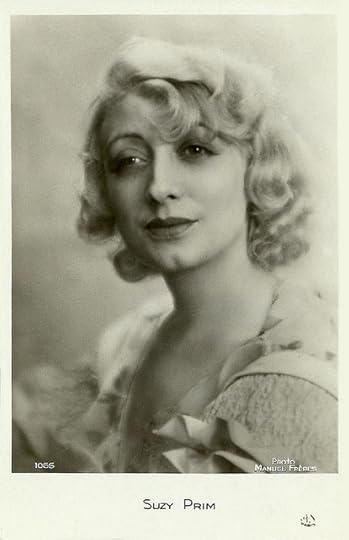
Suzy Prim . French postcard by A.N., Paris, no. 1066. Photo: Manuel Frères. Collection: Didier Hanson.
Sources: Christophe Lawniczak and Philippe Pelletier (CineArtistes) (French), Wikipedia (French) and .

French postcard by Coquemer Gravures, Paris. Photo: Gerschel / Gaumont. Still for La nouvelle mission de Judex (Louis Feuillade, 1917-1918).
Countless Witty Characters
Joseph Marcel Lévesque was born in the Montmartre district of Paris in 1877.
He entered the Paris Conservatory but left quickly enough to make his stage debut in 1896. In 1900, he joined the cast of the Théâtre de l’Athénée, where for five years he forged a reputation as an actor who easily changed from comedy to drama.
Afterwards he also played at the Odeon and the Palais Royal. Like so many other stage performers, the film world discovered his talent, as of 1909. Lévesque started to appear in various shorts, but little is known about this.
He did act with Jean Dax and Nelly Cormon in the short historical film L’arrestation de la Duchesse de Berry/The arrest of the Duchess of Berry (André Calmettes, 1910) for Films d'Art (Pathé).
In 1913, he joined Gaumont where he met actor-director Léonce Perret for whom he wrote La belle-mère/The Stepmother (1913) with Suzanne Le Bret, followed by Léonce et Poupette (1913), which he scripted as well and in which he played Léonce’s man servant.
He followed this with the lead in L’illustre Mâchefer/The Illustrious Clinker (1913), directed by Louis Feuillade, who would become his regular director between 1913 and 1918 and which whom he acted in almost 30 films plus some serials.
Feuillade would have him play countless witty characters in the comedy series La vie drôle/Funny Life.
Meanwhile, Marcel Lévesque had tried his luck at film direction at Gaumont with La pintade et le dindon/Guinea pig and fowl (1915) with Madeleine Guitty as his partner.
Feuillade also used him in more mature roles for his crime serials Les Vampires/The Vampires (1915-1916) with the dangerous Musidora – Lévesque played Oscar Mazamette - and Judex (1916-1917).
In Judex he played the unpredictable Cocantin, a role he resumed in Feuillade’s sequel La nouvelle mission de Judex/The New Mission of Judex (1917-1918), again with René Cresté as the protagonist.
Lévesque also played in a parody of the crime serials, Le pied qui étreint (1916) by Jacques Feyder, with again Musidora, René Poyen (Bout de Zan) and André Roanne .

Italian postcard by Ed. G.B. Falci, Milano. Photo: publicity still for La dame de Chez Maxim's (Amleto Palermi, 1923) with Pina Menichelli .
Extraordinary, Subtle And Discreet Performance
Although Marcel Lévesque did not always have the lead in his films, his extraordinary, subtle and discreet performance made him steal the scenes in whichever film he acted in.
In 1918, producer Louis Nalpas engaged him for some years to be Serpentin in a burlesque series draped around his character and directed by Jean Durand, occasionally also by Alfred Machin.
Gaston Modot was often his co-actor here.
In 1919 Lévesque also played in the prestigious, two-part exotic drama La sultane de l’amour (René Le Somptier, Charles Burguet, 1919), starring France Dhélia .
In 1920 Marcel Lévesque went back to the theatre to act in Je t’aime (I love you), a new play by Sacha Guitry.
In the early 1920s Lévesque went to Italy to be the comical antagonist of Pina Menichelli in the Georges Feydeau comedies La dama de Chez Maxim's/La dame de chez Maxim’s (Amleto Palermi, 1923) and Occupati d'Amelia/Occupe-toi d’Amélie (Telemaco Ruggeri, 1924). These were Menichelli's last films before she married and retired from the screen.
He also played with Mario Bonnard in Il tacchino/The turkey (1924) and Théodore et Cie (1925) and with Palermi again in Florette e Patapon (1927) with Ossi Oswalda .

French postcard by Coquemer Gravures, Paris. Photo: Gerschel / Gaumont. Still for La nouvelle mission de Judex (Louis Feuillade, 1917-1918).
The Unforgettable, Authority Respecting Concierge
Unlike many other actors from the silent cinema, Marcel Lévesque’s career took a new turn with the advent of the talkies.
He became one of the most important supporting actors in early French sound cinema.
Lévesque played a pharmacist in love with Josseline Gaël in Jacques Tourneur’s drama Tout ça ne vaut pas l’amour/All this is not worth the love, 1931) starring Jean Gabin , and he played a collector of garters in L’affaire Coquelet/The Cockelet Case (Jean Gourguet, 1934).
But most of all he was the unforgettable, authority respecting concierge in Jean Renoir’s Le crime de Monsieur Lange/The Crime of M. Lange (1935-1936), starring Florelle , René Lefèvre and Jules Berry.
In 1936 Lévesque found Sacha Guitry again for Faisons un rêve/Let’s Have a Dream, an adaptation of a play by le Maître written in 1916, and starring Jacqueline Delubac and Raimu .
During the war years Lévesque acted in a handful of films such as Marcel L’Herbier’s La nuit fantastique (1941) with Micheline Presle , Jean Grémilllon’s Lumière d’été (1942) with Madeleine Renaud , and Sacha Guitry’s La Malibran (1943) with Suzy Prim .
Marcel Lévesque played his last film part in 1956 in Sacha Guitry’s Assassins et Voleurs/Thieves and Assassins, starring Jean Poiret and Michel Serrault.
In their biography of Lévesque at CineArtistes . Christophe Lawniczak and Philippe Pelletier mention that in many film encyclopaedias, the name of Marcel Lévesque is mentioned only for the distribution but not in the credits (he replaced Charles Bayard).
At the age of 70, Marcel Lévesque stopped film acting and moved to Couilly-Pont-aux-Dames, where he ran a retirement home for old actors. He died there in 1962.

Suzy Prim . French postcard by A.N., Paris, no. 1066. Photo: Manuel Frères. Collection: Didier Hanson.
Sources: Christophe Lawniczak and Philippe Pelletier (CineArtistes) (French), Wikipedia (French) and .
Published on September 01, 2013 23:00
Rejuvenated
Dear friends,
Another month, a new design. The previous months, I rejuvenated the look of EFSP, bit by bit, here and there, but the postcards, stars and stories will stay vintage.
What's new? Above the blog there's an alphabet so you don't need to scroll along the always growing list of stars when searching for one.
There's also more interspace in the texts. More importantly you can view the postcards now always in full, without double clicking. I'm also using more variety in image sizes.
And there are several more small changes, for which diehards may search on a wet Sunday afternoon.
I hope you like the result. Any suggestions? Let them be heard.
Greetings from Amsterdam!
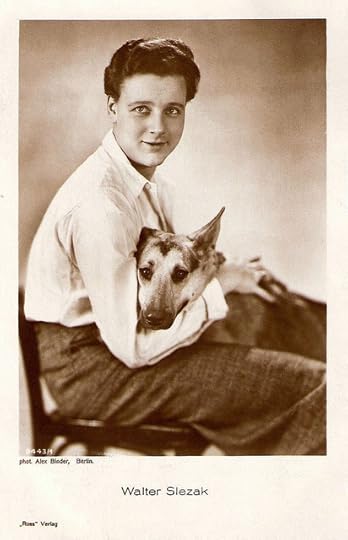
Another month, a new design. The previous months, I rejuvenated the look of EFSP, bit by bit, here and there, but the postcards, stars and stories will stay vintage.
What's new? Above the blog there's an alphabet so you don't need to scroll along the always growing list of stars when searching for one.
There's also more interspace in the texts. More importantly you can view the postcards now always in full, without double clicking. I'm also using more variety in image sizes.
And there are several more small changes, for which diehards may search on a wet Sunday afternoon.
I hope you like the result. Any suggestions? Let them be heard.
Greetings from Amsterdam!

Published on September 01, 2013 02:00
August 31, 2013
Fernanda Negri Pouget
Fernanda Negri Pouget (1889-1955) was an Italian actress who starred in the Italian silent cinema of the 1910s.
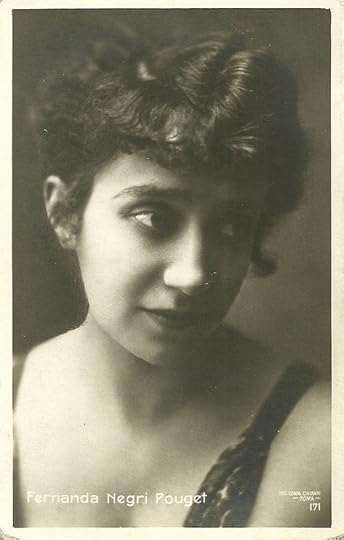
Italian postcard by Vettori, Bologna, no. 171. Photo: Civirani, Rome
Sad Eyes
Fernanda Negri Pouget was born Fernanda Negri in Rome in 1889. She first enrolled as a pupil of the conservatory Accademia Nazionale di Santa Cecilia.
In 1906, she was hired by the new Roman film company Alberini & Santoni (which would become Cines). She debuted in the short Il romanzo di un Pierrot/Romance of a Pierrot (Mario Caserini, 1906).
Until 1909 she mostly played supporting parts, often in film d’art-like films by Mario Caserini such as Romeo e Giulietta/Romeo and Juliet (1908) and Beatrice Cenci (1909), but as of 1909 she also had the female leads in films such as Marco Visconti (Mario Caserini, 1909), La sposa del Nilo/The Bride of the Nile (Enrico Guazzoni, 1911), San Francesco il poverello d’Assisi/St. Francis (Enrico Guazzoni, 1911) and Santa Cecilia/St. Cecilia (Enrique Santos, 1911).
Quite soon the slender, frail looking girl with the sad eyes and the tip-tilted nose became one of the major dramatic actresses of Italian silent cinema, challenging the dominance at Cines of ‘first actress’ Maria Gasperini Caserini, Caserini’s wife.
In 1912, she switched to the Ambrosio film company of Turin, where the year before she had already collaborated in the films L’innocente (Edoardo Bencivenga, 1911), based on Gabriele D’Annunzio’s novel, and La madre e la morte (Arrigo Frusta, 1911).
In L’innocente/The Innocent she played the female lead of Giuliana Hermil, a part which sixty-five years after would be played by Laura Antonelli in Luchino Visconti’s adaptation.
In these years she also married the French actor Armand Pouget , who started acting in films by Ambrosio as of 1912. Henceforth, Fernanda was named Negri Pouget.
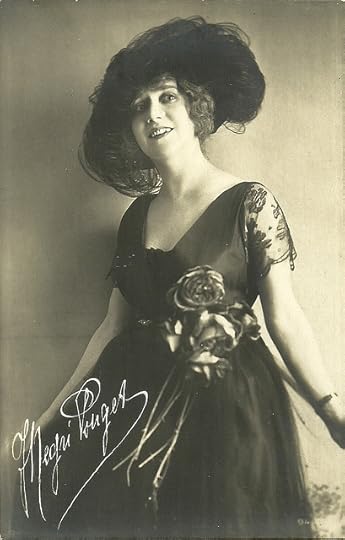
Italian postcard by Fotocelere, Turin.
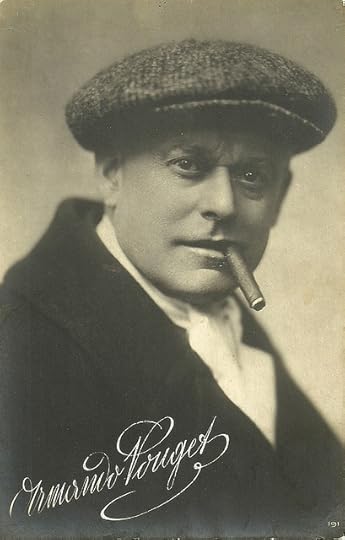
Armand Pouget . Italian postcard by Fotocelere, Turin, no. 191
Facing Real Lions
At Ambrosio, Negri Pouget acted in many films, at first several by Mario Caserini, who had shifted to Ambrosio as well. An example was Nelly, la domatrice/Nellie, the Lion Tamer (Mario Caserini, 1912), in which Negri Pouget faced real lions when playing a female lion tamer. She also acted in films by Luigi Maggi (Satana/Satan, 1912), Febo Mari (Il critico/The Critic, 1913), Eleuterio Rodolfi and others.
In 1913 Negri Pouget peaked in various Ambrosio films. She was Beatrice Portinari in Dante e Beatrice/The Life of Dante (Mario Caserini, 1913), she was a grandmother who remembers her heroic deeds during the Risorgimento in La lampada della nonna/Grandmother's Lamp (Luigi Maggi, 1913), she played a newly discovered film star in Cenerentola/A Modern Cinderella ( Eleuterio Rodolfi , 1913) – the film gives a wonderful image of the Ambrosio studio ‘in action’ at the time.
Finally she was the pitiful blind girl Nidia/Nydia in the Ambrosio version of the epic Gli ultimi giorni di Pompei/The Last Days of Pompeii ( Eleuterio Rodolfi , 1913), while simultaneously the Pasquali company, also of Turin, made a competing version, with Suzanne De Labroy as Nidia.
Later, Negri Pouget had memorable parts in Il dottor Antonio/Doctor Anthony ( Eleuterio Rodolfi , 1914) opposite Hamilton Revelle in the title role, and in the period piece Il leone di Venezia/The Lion of Venice (Luigi Maggi, 1914).
In 1917 she played three outstanding parts, as poor Esther in the adventure film Il fiacre No. 13/Cab Number 13 ( Alberto Capozzi , Gero Zambuto, 1917) with Elena Makowska and Alberto Capozzi , as a little vagabond turned into a painter’s model in Lucciola/Firefly (Augusto Genina, 1917) with again Makowska, and as a tomboy in Maschiaccio/Tomboy (Augusto Genina, 1917) with Vasco Creti.
In the early 1920s, Negri Pouget worked for several other companies, but mainly at the Roman company Nova Film, e.g. acting as Gasperina in the Luigi Pirandello adaptation Ma non è una cosa seria (Augusto Camerini, 1921), co-starring Romano Calò, Ignazio Lupi and Carmen Boni .
Her last performance she gave in 1923 in the film La gola del lupo (Torello Rolli, 1923). According to critic Lucio D'Ambra, Negri Pouget was characterized by the fact that she stayed far from the languid poses of the divas, preferring the expression of a lively performance on the screen.
Fernanda Negri Pouget died in Rome in 1955.
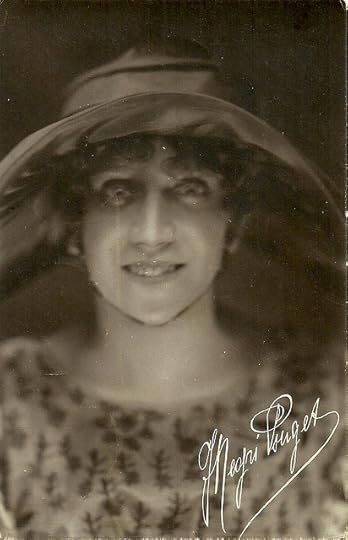
Italian postcard.
Fragment of Cenerentola/A Modern Cinderella (1913). Source: Sempre in penombra (YouTube).
Sources: Sempre in penombra (Italian), Wikipedia (Italian) and .

Italian postcard by Vettori, Bologna, no. 171. Photo: Civirani, Rome
Sad Eyes
Fernanda Negri Pouget was born Fernanda Negri in Rome in 1889. She first enrolled as a pupil of the conservatory Accademia Nazionale di Santa Cecilia.
In 1906, she was hired by the new Roman film company Alberini & Santoni (which would become Cines). She debuted in the short Il romanzo di un Pierrot/Romance of a Pierrot (Mario Caserini, 1906).
Until 1909 she mostly played supporting parts, often in film d’art-like films by Mario Caserini such as Romeo e Giulietta/Romeo and Juliet (1908) and Beatrice Cenci (1909), but as of 1909 she also had the female leads in films such as Marco Visconti (Mario Caserini, 1909), La sposa del Nilo/The Bride of the Nile (Enrico Guazzoni, 1911), San Francesco il poverello d’Assisi/St. Francis (Enrico Guazzoni, 1911) and Santa Cecilia/St. Cecilia (Enrique Santos, 1911).
Quite soon the slender, frail looking girl with the sad eyes and the tip-tilted nose became one of the major dramatic actresses of Italian silent cinema, challenging the dominance at Cines of ‘first actress’ Maria Gasperini Caserini, Caserini’s wife.
In 1912, she switched to the Ambrosio film company of Turin, where the year before she had already collaborated in the films L’innocente (Edoardo Bencivenga, 1911), based on Gabriele D’Annunzio’s novel, and La madre e la morte (Arrigo Frusta, 1911).
In L’innocente/The Innocent she played the female lead of Giuliana Hermil, a part which sixty-five years after would be played by Laura Antonelli in Luchino Visconti’s adaptation.
In these years she also married the French actor Armand Pouget , who started acting in films by Ambrosio as of 1912. Henceforth, Fernanda was named Negri Pouget.

Italian postcard by Fotocelere, Turin.

Armand Pouget . Italian postcard by Fotocelere, Turin, no. 191
Facing Real Lions
At Ambrosio, Negri Pouget acted in many films, at first several by Mario Caserini, who had shifted to Ambrosio as well. An example was Nelly, la domatrice/Nellie, the Lion Tamer (Mario Caserini, 1912), in which Negri Pouget faced real lions when playing a female lion tamer. She also acted in films by Luigi Maggi (Satana/Satan, 1912), Febo Mari (Il critico/The Critic, 1913), Eleuterio Rodolfi and others.
In 1913 Negri Pouget peaked in various Ambrosio films. She was Beatrice Portinari in Dante e Beatrice/The Life of Dante (Mario Caserini, 1913), she was a grandmother who remembers her heroic deeds during the Risorgimento in La lampada della nonna/Grandmother's Lamp (Luigi Maggi, 1913), she played a newly discovered film star in Cenerentola/A Modern Cinderella ( Eleuterio Rodolfi , 1913) – the film gives a wonderful image of the Ambrosio studio ‘in action’ at the time.
Finally she was the pitiful blind girl Nidia/Nydia in the Ambrosio version of the epic Gli ultimi giorni di Pompei/The Last Days of Pompeii ( Eleuterio Rodolfi , 1913), while simultaneously the Pasquali company, also of Turin, made a competing version, with Suzanne De Labroy as Nidia.
Later, Negri Pouget had memorable parts in Il dottor Antonio/Doctor Anthony ( Eleuterio Rodolfi , 1914) opposite Hamilton Revelle in the title role, and in the period piece Il leone di Venezia/The Lion of Venice (Luigi Maggi, 1914).
In 1917 she played three outstanding parts, as poor Esther in the adventure film Il fiacre No. 13/Cab Number 13 ( Alberto Capozzi , Gero Zambuto, 1917) with Elena Makowska and Alberto Capozzi , as a little vagabond turned into a painter’s model in Lucciola/Firefly (Augusto Genina, 1917) with again Makowska, and as a tomboy in Maschiaccio/Tomboy (Augusto Genina, 1917) with Vasco Creti.
In the early 1920s, Negri Pouget worked for several other companies, but mainly at the Roman company Nova Film, e.g. acting as Gasperina in the Luigi Pirandello adaptation Ma non è una cosa seria (Augusto Camerini, 1921), co-starring Romano Calò, Ignazio Lupi and Carmen Boni .
Her last performance she gave in 1923 in the film La gola del lupo (Torello Rolli, 1923). According to critic Lucio D'Ambra, Negri Pouget was characterized by the fact that she stayed far from the languid poses of the divas, preferring the expression of a lively performance on the screen.
Fernanda Negri Pouget died in Rome in 1955.

Italian postcard.
Fragment of Cenerentola/A Modern Cinderella (1913). Source: Sempre in penombra (YouTube).
Sources: Sempre in penombra (Italian), Wikipedia (Italian) and .
Published on August 31, 2013 23:00
August 30, 2013
Richard Attenborough
English actor, film director and producer Richard Attenborough (1923) won two Oscars for Gandhi in 1983. He has also won four BAFTA Awards and three Golden Globe Awards. As an actor he is known for his roles in Brighton Rock (1947), The Great Escape (1963) and Jurassic Park (1993).
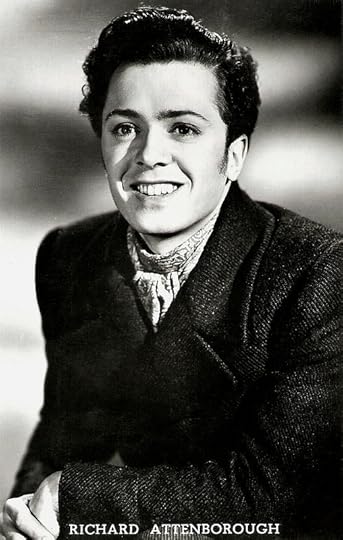
Vintage postcard, no. 950. Photo: British Lion.
Psychopathic Young Gangster
Richard Samuel Attenborough, Baron Attenborough was born in Cambridge, England in 1923. ‘Dickie’ was the eldest of three sons of Mary Attenborough née Clegg a founding member of the Marriage Guidance Council and Frederick Levi Attenborough, a scholar and academic administrator who was a don at Emmanuel College, Cambridge.
Richard’s brothers were nature documentarian David Attenborough and John Attenborough, who was an executive at Alfa Romeo before his death in 2012.
Attenborough was educated at Wyggeston Grammar School for Boys in Leicester and studied at the Royal Academy of Dramatic Art (RADA). At the age of 12, his acting career had started when he appeared in shows at Leicester's Little Theatre.
Attenborough's film career began with an uncredited role as a deserting sailor in the war film In Which We Serve (Noël Coward, David Lean, 1942).
During the Second World War Attenborough served in the Royal Air Force. After initial pilot training he was seconded to the newly-formed RAF Film Unit at Pinewood Studios, under the command of Flight Lieutenant John Boulting where he appeared with Edward G. Robinson in the propaganda film Journey Together (John Boulting, 1943-1945).
He then volunteered to fly with the Film Unit and after further training, where he sustained permanent ear-damage, qualified as a sergeant, flying on several missions over Europe filming from the rear gunner's position to record the outcome of Bomber Command sorties.
After the war, he made his breakthrough as a psychopathic young gangster in the film of Graham Greene's novel Brighton Rock (John Boulting, 1947), a part that he had previously played to great acclaim at the Garrick Theatre in 1942. Brighton Rock received critical acclaim and was the most popular British film of 1947.
After that, he was type-cast for many years as working-class misfits or cowards in films like The Guinea Pig (Roy Boulting, 1948) in which the 26-year-old Attenborough was wholly credible as a 13-year-old schoolboy, London Belongs to Me (Sidney Gilliat, 1948) with Alastair Sim, and the naval drama Morning Departure (Roy Ward Baker, 1950) starring John Mills .
In 1949 exhibitors voted Attenborough the 6th most popular British actor at the box office.
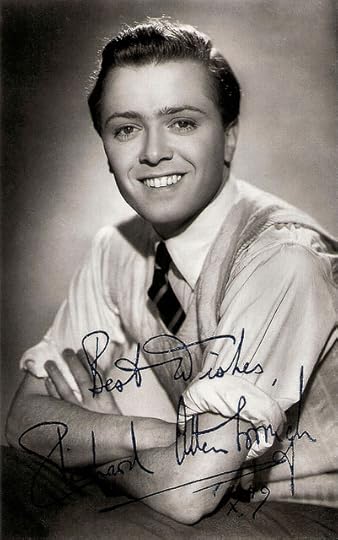
British autograph card, 1949.
Hollywood Blockbuster
In 1952, Richard Attenborough starred in the original West End production of Agatha Christie's The Mousetrap, which went on to become the world's longest-running stage production. He took a 10% profit-participation in the production, which proved to be a wise business decision.
During the 1950s, Attenborough worked prolifically in British films and appeared in successful comedies, such as Private's Progress (Roy Boulting, 1956) opposite Ian Carmichael, and I'm All Right Jack (Roy Boulting, 1959), also with Dennis Price .
In the late 1950s, Attenborough formed a production company, Beaver Films, with Bryan Forbes . He began to build a profile as a producer on projects including the crime drama The League of Gentlemen (Basil Dearden, 1959), the drama The Angry Silence (Guy Green, 1960) with Pier Angeli , and Whistle Down the Wind ( Bryan Forbes , 1961) starring Hayley Mills . In the first two he also performed as an actor.
In 1963 he appeared in the ensemble cast of The Great Escape (John Sturges, 1963) as RAF Squadron Leader Roger Bartlett (‘Big X’), the head of the escape committee and based on the real life exploits of Roger Bushell. It was his first appearance in a major Hollywood blockbuster and his most successful film up to that time.
During the 1960s, he expanded his range of character roles in films such as Séance on a Wet Afternoon (Bryan Forbes, 1964) and Guns at Batasi (John Guillermin, 1964), for which he won the BAFTA Award for Best Actor for his portrayal of the Regimental Sergeant Major (RSM).
In 1965 he played Lew Moran opposite James Stewart in The Flight of the Phoenix (Robert Aldrich, 1965) and in 1967 and 1968, he won back-to-back Golden Globe Awards in the category of Best Supporting Actor, the first time for The Sand Pebbles (Robert Wise, 1967), co-starring Steve McQueen, and the second time for his comedic turn as a circus owner in Doctor Dolittle (Richard Fleischer, 1968), starring Rex Harrison .
His feature film directorial debut was the all-star screen version of the hit musical Oh! What a Lovely War (Richard Attenborough, 1969). Sergio Angelini in Directors in British and Irish Cinema : “a project inherited from John Mills , who had developed the screenplay with Len Deighton from Joan Littlewood's stage production. This satiric fantasia on the First World War is largely set on Brighton Pier, but Attenborough and cinematographer Gerry Turpin successfully open out the play with a number of bravura sequences, the best remembered being the final shot which pulls back to reveal an entire hillside covered in white crosses.”
He later directed two epic period films: Young Winston (Richard Attenborough, 1972), which starred his favourite leading man, Anthony Hopkins, as Winston Churchill, and A Bridge Too Far (Richard Attenborough, 1977), an all-star account of Operation Market Garden in World War II.
His acting appearances became sporadic as he concentrated more on directing and producing. His portrayal of the serial killer John Christie in 10 Rillington Place (Richard Fleischer, 1971) garnered excellent reviews and he also played to great acclaim in Indian director Satyajit Ray's period piece The Chess Players (1977).
Following his appearance in The Human Factor (Otto Preminger, 1979), he stopped with film acting for more than a decade.
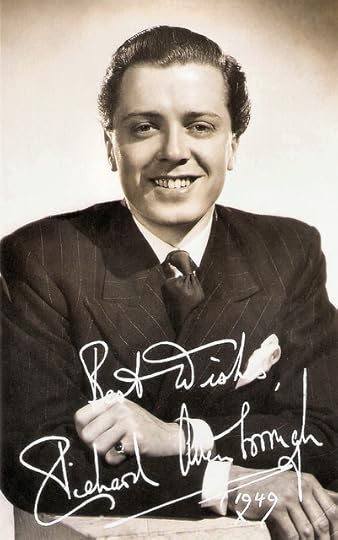
British autograph card, 1949.
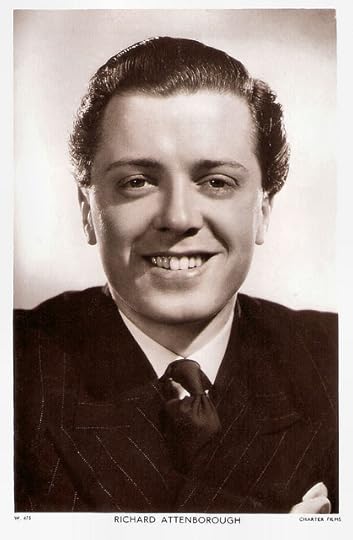
British postcard in the Picturegoer Series, London, no. W 475. Photo: Charter Films.
In Search of Gandhi
In 1982, Richard Attenborough finally realized a project he had been attempting to get made for 18 years: Gandhi, featuring Ben Kingsley. It proved to be an enormous commercial and critical success. Gandhi won eight Academy Awards, and Attenborough himself was awarded with the Oscar for Best Director and as the film's producer, the Oscar for Best Picture. For his historical epic, he also won the Golden Globe as Best Director in 1983. He published his book In Search of Gandhi, another product of his fascination with the Indian leader.
Attenborough then directed the screen version of the musical A Chorus Line (Richard Attenborough, 1985) and the anti-apartheid drama Cry Freedom (Richard Attenborough, 1987), based on the life and death of the prominent anti-apartheid activist Steve Biko and the experiences of Donald Woods. He was nominated for a Golden Globe Award for Best Director for both films.
His more recent films as director and producer include the underrated Chaplin (Richard Attenborough, 1992) starring Robert Downey, Jr. as Charlie Chaplin and Shadowlands (Richard Attenborough, 1993), based on the relationship between C.S. Lewis (Anthony Hopkins) and Joy Gresham (Debra Winger).
He made his come-back as an actor as the eccentric owner of a dinosaur theme park in Jurassic Park (Steven Spielberg, 1993) and the sequel, The Lost World: Jurassic Park (Steven Spielberg, 1997).
He also starred in the remake of Miracle on 34th Street (Les Mayfield, 1994). Since then he has made occasional appearances in supporting roles, including as Sir William Cecil in the historical drama Elizabeth (Shekhar Kapur,1998) with Cate Blanchett, Jacob in Joseph and the Amazing Technicolor Dreamcoat (David Mallet, 1999) and as The Narrator in the film adaptation of Spike Milligan's comedy book Puckoon (Terence Ryan 2002).
He made his only appearance in a Shakespeare film when he played the British ambassador who announces that Rosencrantz and Guildenstern are dead at the end of Kenneth Branagh's Hamlet (1996).
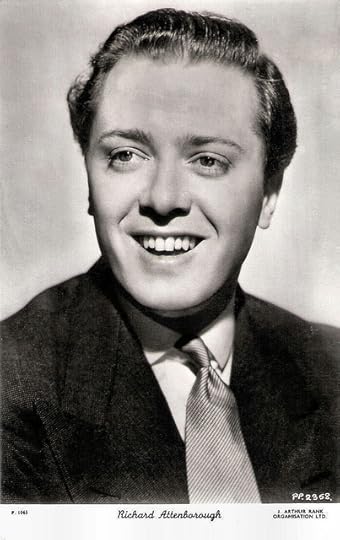
British postcard by Show Parade Picture Service, London, in the series 'The People', no. P1065. Photo: J. Arthur Rank Organisation Ltd.
Entirely Up to You, Darling
Richard Attenborough has been married to English actress Sheila Sim since 1945. With his wife, they founded the Richard and Sheila Attenborough Visual Arts Centre.
He also founded the Jane Holland Creative Centre for Learning at Waterford Kamhlaba in Swaziland in memory of his elder daughter. Jane Holland, her mother-in-law, and her 15-year-old daughter Lucy were killed in 2004 when a tsunami caused by the Indian Ocean earthquake struck Khao Lak, Thailand where they were holidaying.
Attenborough has two other children, Michael and Charlotte, an actress. Michael is a theatre director and the Artistic director of the Almeida Theatre in London.
In 1967, Richard Attenborough was made a Commander of the Order of the British Empire (CBE). He was knighted in 1976 and in 1993 he was made a life peer as Baron Attenborough, of Richmond upon Thames. At 84, he made his last film as director and producer, Closing the Ring (Richard Attenborough, 2007).
According to Jason Buchanan at AllMovie , “Sixty-five years after making his screen debut as a young stoker in co-directors Noël Coward and David Lean's World War II drama In Which We Serve, Richard Attenborough perfects the balance between epic story and intimate tale with this drama starring Shirley MacLaine and Neve Campbell as a mother and daughter who find a relic from the past sparking an incendiary series of events.”
Attenborough served as vice president (1973–1995) and president (2002–2010) of the British Academy of Film and Television Arts and as president of the Royal Academy of Dramatic Art (2003– ). For 33 years he was President of the Muscular Dystrophy campaign, and he is also the patron of the United World Colleges movement. He passionately believes in education, primarily education that does not judge upon colour, race, creed or religion.
In 2008 Attenborough published, in association with his long standing associate Diana Hawkins, an informal autobiography Entirely Up to You, Darling.
Later that year he entered hospital with heart problems and was fitted with a pacemaker. In December 2008 he suffered a fall at his home after a stroke, and went into a coma, but came out of it within a few days. Shortly before her 90th birthday, in June 2012 Sheila Sim entered the actors' home Denville Hall, for which she and Attenborough had helped raise funds.
In March 2013, in light of his deteriorating health, Attenborough moved into Denville Hall to be with his wife.
Scene from Brighton Rock (1947). Source: Legendy2k (YouTube).
Trailer for Gandhi (1982). Source: 05HK09 (YouTube).
Sources: Sergio Angelini (Directors in British and Irish Cinema), Jason Buchanan (AllMovie), Encyclopaedia Britannica, AllMovie, Wikipedia and .

Vintage postcard, no. 950. Photo: British Lion.
Psychopathic Young Gangster
Richard Samuel Attenborough, Baron Attenborough was born in Cambridge, England in 1923. ‘Dickie’ was the eldest of three sons of Mary Attenborough née Clegg a founding member of the Marriage Guidance Council and Frederick Levi Attenborough, a scholar and academic administrator who was a don at Emmanuel College, Cambridge.
Richard’s brothers were nature documentarian David Attenborough and John Attenborough, who was an executive at Alfa Romeo before his death in 2012.
Attenborough was educated at Wyggeston Grammar School for Boys in Leicester and studied at the Royal Academy of Dramatic Art (RADA). At the age of 12, his acting career had started when he appeared in shows at Leicester's Little Theatre.
Attenborough's film career began with an uncredited role as a deserting sailor in the war film In Which We Serve (Noël Coward, David Lean, 1942).
During the Second World War Attenborough served in the Royal Air Force. After initial pilot training he was seconded to the newly-formed RAF Film Unit at Pinewood Studios, under the command of Flight Lieutenant John Boulting where he appeared with Edward G. Robinson in the propaganda film Journey Together (John Boulting, 1943-1945).
He then volunteered to fly with the Film Unit and after further training, where he sustained permanent ear-damage, qualified as a sergeant, flying on several missions over Europe filming from the rear gunner's position to record the outcome of Bomber Command sorties.
After the war, he made his breakthrough as a psychopathic young gangster in the film of Graham Greene's novel Brighton Rock (John Boulting, 1947), a part that he had previously played to great acclaim at the Garrick Theatre in 1942. Brighton Rock received critical acclaim and was the most popular British film of 1947.
After that, he was type-cast for many years as working-class misfits or cowards in films like The Guinea Pig (Roy Boulting, 1948) in which the 26-year-old Attenborough was wholly credible as a 13-year-old schoolboy, London Belongs to Me (Sidney Gilliat, 1948) with Alastair Sim, and the naval drama Morning Departure (Roy Ward Baker, 1950) starring John Mills .
In 1949 exhibitors voted Attenborough the 6th most popular British actor at the box office.

British autograph card, 1949.
Hollywood Blockbuster
In 1952, Richard Attenborough starred in the original West End production of Agatha Christie's The Mousetrap, which went on to become the world's longest-running stage production. He took a 10% profit-participation in the production, which proved to be a wise business decision.
During the 1950s, Attenborough worked prolifically in British films and appeared in successful comedies, such as Private's Progress (Roy Boulting, 1956) opposite Ian Carmichael, and I'm All Right Jack (Roy Boulting, 1959), also with Dennis Price .
In the late 1950s, Attenborough formed a production company, Beaver Films, with Bryan Forbes . He began to build a profile as a producer on projects including the crime drama The League of Gentlemen (Basil Dearden, 1959), the drama The Angry Silence (Guy Green, 1960) with Pier Angeli , and Whistle Down the Wind ( Bryan Forbes , 1961) starring Hayley Mills . In the first two he also performed as an actor.
In 1963 he appeared in the ensemble cast of The Great Escape (John Sturges, 1963) as RAF Squadron Leader Roger Bartlett (‘Big X’), the head of the escape committee and based on the real life exploits of Roger Bushell. It was his first appearance in a major Hollywood blockbuster and his most successful film up to that time.
During the 1960s, he expanded his range of character roles in films such as Séance on a Wet Afternoon (Bryan Forbes, 1964) and Guns at Batasi (John Guillermin, 1964), for which he won the BAFTA Award for Best Actor for his portrayal of the Regimental Sergeant Major (RSM).
In 1965 he played Lew Moran opposite James Stewart in The Flight of the Phoenix (Robert Aldrich, 1965) and in 1967 and 1968, he won back-to-back Golden Globe Awards in the category of Best Supporting Actor, the first time for The Sand Pebbles (Robert Wise, 1967), co-starring Steve McQueen, and the second time for his comedic turn as a circus owner in Doctor Dolittle (Richard Fleischer, 1968), starring Rex Harrison .
His feature film directorial debut was the all-star screen version of the hit musical Oh! What a Lovely War (Richard Attenborough, 1969). Sergio Angelini in Directors in British and Irish Cinema : “a project inherited from John Mills , who had developed the screenplay with Len Deighton from Joan Littlewood's stage production. This satiric fantasia on the First World War is largely set on Brighton Pier, but Attenborough and cinematographer Gerry Turpin successfully open out the play with a number of bravura sequences, the best remembered being the final shot which pulls back to reveal an entire hillside covered in white crosses.”
He later directed two epic period films: Young Winston (Richard Attenborough, 1972), which starred his favourite leading man, Anthony Hopkins, as Winston Churchill, and A Bridge Too Far (Richard Attenborough, 1977), an all-star account of Operation Market Garden in World War II.
His acting appearances became sporadic as he concentrated more on directing and producing. His portrayal of the serial killer John Christie in 10 Rillington Place (Richard Fleischer, 1971) garnered excellent reviews and he also played to great acclaim in Indian director Satyajit Ray's period piece The Chess Players (1977).
Following his appearance in The Human Factor (Otto Preminger, 1979), he stopped with film acting for more than a decade.

British autograph card, 1949.

British postcard in the Picturegoer Series, London, no. W 475. Photo: Charter Films.
In Search of Gandhi
In 1982, Richard Attenborough finally realized a project he had been attempting to get made for 18 years: Gandhi, featuring Ben Kingsley. It proved to be an enormous commercial and critical success. Gandhi won eight Academy Awards, and Attenborough himself was awarded with the Oscar for Best Director and as the film's producer, the Oscar for Best Picture. For his historical epic, he also won the Golden Globe as Best Director in 1983. He published his book In Search of Gandhi, another product of his fascination with the Indian leader.
Attenborough then directed the screen version of the musical A Chorus Line (Richard Attenborough, 1985) and the anti-apartheid drama Cry Freedom (Richard Attenborough, 1987), based on the life and death of the prominent anti-apartheid activist Steve Biko and the experiences of Donald Woods. He was nominated for a Golden Globe Award for Best Director for both films.
His more recent films as director and producer include the underrated Chaplin (Richard Attenborough, 1992) starring Robert Downey, Jr. as Charlie Chaplin and Shadowlands (Richard Attenborough, 1993), based on the relationship between C.S. Lewis (Anthony Hopkins) and Joy Gresham (Debra Winger).
He made his come-back as an actor as the eccentric owner of a dinosaur theme park in Jurassic Park (Steven Spielberg, 1993) and the sequel, The Lost World: Jurassic Park (Steven Spielberg, 1997).
He also starred in the remake of Miracle on 34th Street (Les Mayfield, 1994). Since then he has made occasional appearances in supporting roles, including as Sir William Cecil in the historical drama Elizabeth (Shekhar Kapur,1998) with Cate Blanchett, Jacob in Joseph and the Amazing Technicolor Dreamcoat (David Mallet, 1999) and as The Narrator in the film adaptation of Spike Milligan's comedy book Puckoon (Terence Ryan 2002).
He made his only appearance in a Shakespeare film when he played the British ambassador who announces that Rosencrantz and Guildenstern are dead at the end of Kenneth Branagh's Hamlet (1996).

British postcard by Show Parade Picture Service, London, in the series 'The People', no. P1065. Photo: J. Arthur Rank Organisation Ltd.
Entirely Up to You, Darling
Richard Attenborough has been married to English actress Sheila Sim since 1945. With his wife, they founded the Richard and Sheila Attenborough Visual Arts Centre.
He also founded the Jane Holland Creative Centre for Learning at Waterford Kamhlaba in Swaziland in memory of his elder daughter. Jane Holland, her mother-in-law, and her 15-year-old daughter Lucy were killed in 2004 when a tsunami caused by the Indian Ocean earthquake struck Khao Lak, Thailand where they were holidaying.
Attenborough has two other children, Michael and Charlotte, an actress. Michael is a theatre director and the Artistic director of the Almeida Theatre in London.
In 1967, Richard Attenborough was made a Commander of the Order of the British Empire (CBE). He was knighted in 1976 and in 1993 he was made a life peer as Baron Attenborough, of Richmond upon Thames. At 84, he made his last film as director and producer, Closing the Ring (Richard Attenborough, 2007).
According to Jason Buchanan at AllMovie , “Sixty-five years after making his screen debut as a young stoker in co-directors Noël Coward and David Lean's World War II drama In Which We Serve, Richard Attenborough perfects the balance between epic story and intimate tale with this drama starring Shirley MacLaine and Neve Campbell as a mother and daughter who find a relic from the past sparking an incendiary series of events.”
Attenborough served as vice president (1973–1995) and president (2002–2010) of the British Academy of Film and Television Arts and as president of the Royal Academy of Dramatic Art (2003– ). For 33 years he was President of the Muscular Dystrophy campaign, and he is also the patron of the United World Colleges movement. He passionately believes in education, primarily education that does not judge upon colour, race, creed or religion.
In 2008 Attenborough published, in association with his long standing associate Diana Hawkins, an informal autobiography Entirely Up to You, Darling.
Later that year he entered hospital with heart problems and was fitted with a pacemaker. In December 2008 he suffered a fall at his home after a stroke, and went into a coma, but came out of it within a few days. Shortly before her 90th birthday, in June 2012 Sheila Sim entered the actors' home Denville Hall, for which she and Attenborough had helped raise funds.
In March 2013, in light of his deteriorating health, Attenborough moved into Denville Hall to be with his wife.
Scene from Brighton Rock (1947). Source: Legendy2k (YouTube).
Trailer for Gandhi (1982). Source: 05HK09 (YouTube).
Sources: Sergio Angelini (Directors in British and Irish Cinema), Jason Buchanan (AllMovie), Encyclopaedia Britannica, AllMovie, Wikipedia and .
Published on August 30, 2013 23:00
August 29, 2013
Valeska Gert
For Jan.
Jewish cabaret artist Valeska Gert (1892-1978) became famous in Berlin with her radical modern dances. With her dark, aquiline features. she was also active as an artists' model and appeared in several classics of the Weimar Cinema. After a comeback in Fellini’s Giulietta degli spiriti/Juliet of the Spirits (1965), Gert worked with the film makers of the New German Cinema of the 1970s.

German card. Photo: Atelier Leopold, München (Munich). Collection: Didier Hanson.
Dadaist Mixed Media Art Nights
Valeska Gert was born as Gertrud Valesca Samosch in 1892 in Berlin to a Jewish family. She was the eldest daughter of manufacturer Theodor Samosch and Augusta Rosenthal.
Exhibiting no interest in academics or office work, Gert began taking dance lessons at the age of nine. This, combined with her love of ornate fashion, was the basis for her career in dance and performance art.
In 1915, she studied acting with Maria Moissi.
World War I had a negative effect on her father’s finances, forcing Gert to rely on herself far more than other bourgeois daughters typically might. As World War I raged on, Gert joined a Berliner dance group and created revolutionary satirical dance.
In 1916, Gert made her dance debut in a Berlin film house, performing between film reels. The same year, she began acting at the Munich Kammerspiele.
Following engagements at the Deutsches Theater and the Tribüne in Berlin, Gert was invited to perform in expressionist plays in Dadaist mixed media art nights. Her performances in Oskar Kokoschka’s Hiob (1918), Ernst Toller’s Transformation (1919), and Frank Wedekind’s Franziska earned her popularity.
During this time, she also performed in the Schall und Rauch cabaret. Gert launched a tour of her own dances, with titles like Dance in Orange, Boxing, Circus, Japanese Grotesque, Death, and Whore. With her highly athletic style of dance, she created a sensation.
She also contributed articles for magazines like Die Weltbühne and the Berliner Tageszeitung.
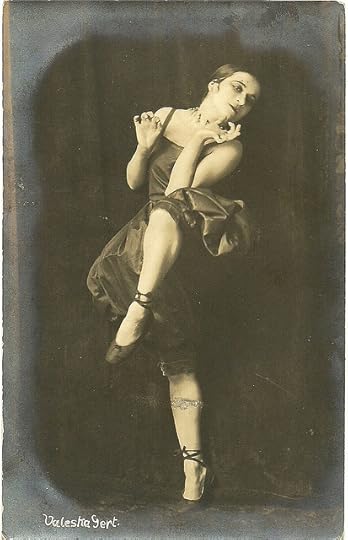
German card. Collection: Didier Hanson.
A Social Conscience Melodrama
By 1923, Valeska Gert focused her work more on film acting than live performance.
She played Puck in the Ufa production Ein Sommernachtstraum/Wood Love (Hans Neumann, 1925). This adaptation of William Shakespeare's A Midsummer Night's Dream had an all-star cast including Werner Krauss , Alexander Granach en Hans Albers .
In 1925 she also appeared in the classic Die freudlose Gasse/Joyless Street (G. W. Pabst, 1925), starring Asta Nielsen and the young Greta Garbo in her second major role.
Craig Butler at AllMovie : “Street is not about any one person but about a time, a place and, above all, a society that was perilously divided into two very unequal parts. Director G.W. Pabst and scenarist Willy Haas have created a social conscience melodrama that is enormously powerful; it's manipulative at times, but there's such commitment behind it that most viewers won't mind. Pabst is excellent at exploring the bleakness and despair of the residents of the Street and contrasting it with the amorality and immorality of the upper classes, who think nothing of spreading false rumors that will destroy many but will increase their own already considerable wealth.”
Gert also performed in G. W. Pabst’s Tagebuch einer Verlorenen/Diary of a Lost Girl (G. W. Pabst, 1929), and Die 3-Groschen-Oper/The Threepenny Opera (G. W. Pabst, 1931), loosely based on the 1928 musical theatre success The Threepenny Opera by Bertolt Brecht and Kurt Weill.
Gert played Mrs. Peachum, and according to Hal Erickson at AllMovie the film version “is every bit as good as the stage original, and sometimes even better.”
In France she appeared in Jean Renoir’s second film Nana (1926), a lavishly appointed adaptation of Emile Zola's novel. Other classic silent films with her were the science fiction horror film Alraune/Mandrake (Henrik Galeen, 1928) featuring Brigitte Helm , and Menschen am Sonntag/People on Sunday (Robert Siodmak, Rochus Gliese, Edgar G. Ulmer, 1930), based on a screenplay by Billy Wilder.
In the late twenties, Gert returned to the stage with pieces emphasizing Tontänze (sound dances), which explored the relationship between movement and sound.
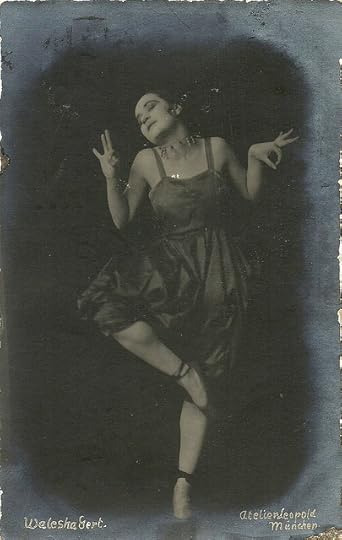
German card. Photo: Atelier Leopold, München (Munich). Collection: Didier Hanson.
Exile
In 1933, Valeska Gert’s Jewish heritage resulted in her ban from the German stage. Her exile from performance in Germany sent her to London for some time, where she worked both in theatre and film.
In London she worked on the experimental short film Pett and Pot (Alberto Cavalcanti, 1934), which would long stand as her last film.
In 1936, Gert wed an English writer, Robin Hay Anderson. It was her second marriage and her first husband had been Helmuth von Krause.
In 1938, she emigrated to the United States, where it was difficult for her to continue her previous career. She lived on the welfare of a Jewish refugee community and found work washing dishes and sometimes posing as a nude model.
This same year, she hired the 17-year old Georg Kreisler as a rehearsal pianist to continue focus on cabaret work.
By 1941, she had opened the Beggar Bar in New York, where Julian Beck, Judith Malina, and Jackson Pollock worked for her. Tennessee Williams also worked for her for a short time as a busboy, but was fired for refusing to pool his tips.
By 1944, Gert had relocated to Provincetown, Massachusetts, where she opened Valeska's. During this period, Gert was called to Provincetown court for throwing garbage out of her window and failing to pay a dance partner. She called upon Williams as a character witness, which he did with pleasure, despite the fact that she fired him. He told incredulous friends that he "simply liked her".
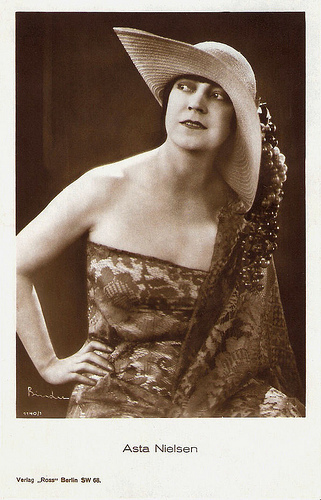
Asta Nielsen . German postcard by Ross Verlag, no. 1140/1, 1927-1928. Photo: Alex Binder, Berlin.
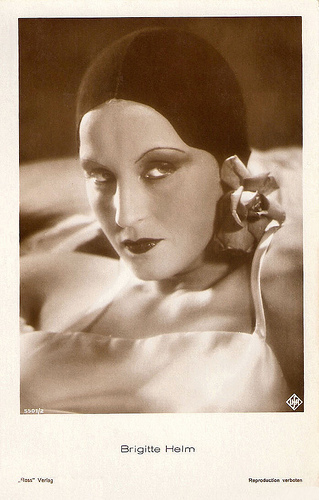
Brigitte Helm . German postcard by Ross Verlag, no. 5501/2, 1930-1931. Photo: Ufa. Distributed in Italy by Ballerini& Frattini, Florence.
Fellini and Fassbinder
In 1947 Valeska Gert returned to Europe. After stays in Paris and Zurich, she went to Blockaded Berlin in 1949, where she opened the cabaret Hexenküche (Witch's Kitchen) in the next year. Following Hexenküche, she opened Ziegenstall on the island of Sylt.
In the 1960s, she made her screen comeback. She was rediscovered by Federico Fellini who gave her a part in his film Giulietta degli spiriti/Juliet of the Spirits (1965), featuring Giulietta Masina .
The film brought her to the attention of a new generation of German directors. During the 1970s, she played in an episode of Rainer Werner Fassbinder's serial Acht Stunden sind kein Tag/Eight Hours are Not a Day (1973), the experimental film Die Betörung der blauen Matrosen/The Enchantment of the Blue Sailors (Tabea Blumenschein, Ulrike Ottinger, 1975) and in Volker Schlöndorff's Der Fangschuss/Coup de grâce (1976), with Matthias Habich.
Schlöndorff also made a documentary about her, Nur zum Spaß, nur zum/Just for fun, just for the game (1977). Gert told in this film about theatre in Berlin in the 1920s, and her dances were re-created by Pola Kinski.
In 1978 Werner Herzog invited Gert to play the real estate broker Knock in his remake of F.W. Murnau's classic film Nosferatu, but she died just two weeks later before filming began.
On 18 March 1978 neighbours and friends in Kampen, Germany, reported she had not been seen for four days. When her door was forced in the presence of police she was found dead. She was 86 years old.
In 1970. she had been awarded with the Filmband in Gold for lifelong achievement in German film.
Valeska Gert’s art was for the first time exhibited in 2010 in the Berlin Museum for Contemporary Art Hamburger Bahnhof.
Valeska Gert - Die Frau im Taumel des Lasters. Short scene from the documentary Cabaret Berlin - Die wilde Bühne 1919 - 1933. Source: dict adtv (YouTube)
Scene from Der Fangschuss/Coup de grâce (1976). Source: Matcarriere (YouTube).
Sources: Thomas Staedeli (Cyranos), Craig Butler (AllMovie), Hal Erickson (AllMovie), Wikipedia and .
Jewish cabaret artist Valeska Gert (1892-1978) became famous in Berlin with her radical modern dances. With her dark, aquiline features. she was also active as an artists' model and appeared in several classics of the Weimar Cinema. After a comeback in Fellini’s Giulietta degli spiriti/Juliet of the Spirits (1965), Gert worked with the film makers of the New German Cinema of the 1970s.

German card. Photo: Atelier Leopold, München (Munich). Collection: Didier Hanson.
Dadaist Mixed Media Art Nights
Valeska Gert was born as Gertrud Valesca Samosch in 1892 in Berlin to a Jewish family. She was the eldest daughter of manufacturer Theodor Samosch and Augusta Rosenthal.
Exhibiting no interest in academics or office work, Gert began taking dance lessons at the age of nine. This, combined with her love of ornate fashion, was the basis for her career in dance and performance art.
In 1915, she studied acting with Maria Moissi.
World War I had a negative effect on her father’s finances, forcing Gert to rely on herself far more than other bourgeois daughters typically might. As World War I raged on, Gert joined a Berliner dance group and created revolutionary satirical dance.
In 1916, Gert made her dance debut in a Berlin film house, performing between film reels. The same year, she began acting at the Munich Kammerspiele.
Following engagements at the Deutsches Theater and the Tribüne in Berlin, Gert was invited to perform in expressionist plays in Dadaist mixed media art nights. Her performances in Oskar Kokoschka’s Hiob (1918), Ernst Toller’s Transformation (1919), and Frank Wedekind’s Franziska earned her popularity.
During this time, she also performed in the Schall und Rauch cabaret. Gert launched a tour of her own dances, with titles like Dance in Orange, Boxing, Circus, Japanese Grotesque, Death, and Whore. With her highly athletic style of dance, she created a sensation.
She also contributed articles for magazines like Die Weltbühne and the Berliner Tageszeitung.

German card. Collection: Didier Hanson.
A Social Conscience Melodrama
By 1923, Valeska Gert focused her work more on film acting than live performance.
She played Puck in the Ufa production Ein Sommernachtstraum/Wood Love (Hans Neumann, 1925). This adaptation of William Shakespeare's A Midsummer Night's Dream had an all-star cast including Werner Krauss , Alexander Granach en Hans Albers .
In 1925 she also appeared in the classic Die freudlose Gasse/Joyless Street (G. W. Pabst, 1925), starring Asta Nielsen and the young Greta Garbo in her second major role.
Craig Butler at AllMovie : “Street is not about any one person but about a time, a place and, above all, a society that was perilously divided into two very unequal parts. Director G.W. Pabst and scenarist Willy Haas have created a social conscience melodrama that is enormously powerful; it's manipulative at times, but there's such commitment behind it that most viewers won't mind. Pabst is excellent at exploring the bleakness and despair of the residents of the Street and contrasting it with the amorality and immorality of the upper classes, who think nothing of spreading false rumors that will destroy many but will increase their own already considerable wealth.”
Gert also performed in G. W. Pabst’s Tagebuch einer Verlorenen/Diary of a Lost Girl (G. W. Pabst, 1929), and Die 3-Groschen-Oper/The Threepenny Opera (G. W. Pabst, 1931), loosely based on the 1928 musical theatre success The Threepenny Opera by Bertolt Brecht and Kurt Weill.
Gert played Mrs. Peachum, and according to Hal Erickson at AllMovie the film version “is every bit as good as the stage original, and sometimes even better.”
In France she appeared in Jean Renoir’s second film Nana (1926), a lavishly appointed adaptation of Emile Zola's novel. Other classic silent films with her were the science fiction horror film Alraune/Mandrake (Henrik Galeen, 1928) featuring Brigitte Helm , and Menschen am Sonntag/People on Sunday (Robert Siodmak, Rochus Gliese, Edgar G. Ulmer, 1930), based on a screenplay by Billy Wilder.
In the late twenties, Gert returned to the stage with pieces emphasizing Tontänze (sound dances), which explored the relationship between movement and sound.

German card. Photo: Atelier Leopold, München (Munich). Collection: Didier Hanson.
Exile
In 1933, Valeska Gert’s Jewish heritage resulted in her ban from the German stage. Her exile from performance in Germany sent her to London for some time, where she worked both in theatre and film.
In London she worked on the experimental short film Pett and Pot (Alberto Cavalcanti, 1934), which would long stand as her last film.
In 1936, Gert wed an English writer, Robin Hay Anderson. It was her second marriage and her first husband had been Helmuth von Krause.
In 1938, she emigrated to the United States, where it was difficult for her to continue her previous career. She lived on the welfare of a Jewish refugee community and found work washing dishes and sometimes posing as a nude model.
This same year, she hired the 17-year old Georg Kreisler as a rehearsal pianist to continue focus on cabaret work.
By 1941, she had opened the Beggar Bar in New York, where Julian Beck, Judith Malina, and Jackson Pollock worked for her. Tennessee Williams also worked for her for a short time as a busboy, but was fired for refusing to pool his tips.
By 1944, Gert had relocated to Provincetown, Massachusetts, where she opened Valeska's. During this period, Gert was called to Provincetown court for throwing garbage out of her window and failing to pay a dance partner. She called upon Williams as a character witness, which he did with pleasure, despite the fact that she fired him. He told incredulous friends that he "simply liked her".

Asta Nielsen . German postcard by Ross Verlag, no. 1140/1, 1927-1928. Photo: Alex Binder, Berlin.

Brigitte Helm . German postcard by Ross Verlag, no. 5501/2, 1930-1931. Photo: Ufa. Distributed in Italy by Ballerini& Frattini, Florence.
Fellini and Fassbinder
In 1947 Valeska Gert returned to Europe. After stays in Paris and Zurich, she went to Blockaded Berlin in 1949, where she opened the cabaret Hexenküche (Witch's Kitchen) in the next year. Following Hexenküche, she opened Ziegenstall on the island of Sylt.
In the 1960s, she made her screen comeback. She was rediscovered by Federico Fellini who gave her a part in his film Giulietta degli spiriti/Juliet of the Spirits (1965), featuring Giulietta Masina .
The film brought her to the attention of a new generation of German directors. During the 1970s, she played in an episode of Rainer Werner Fassbinder's serial Acht Stunden sind kein Tag/Eight Hours are Not a Day (1973), the experimental film Die Betörung der blauen Matrosen/The Enchantment of the Blue Sailors (Tabea Blumenschein, Ulrike Ottinger, 1975) and in Volker Schlöndorff's Der Fangschuss/Coup de grâce (1976), with Matthias Habich.
Schlöndorff also made a documentary about her, Nur zum Spaß, nur zum/Just for fun, just for the game (1977). Gert told in this film about theatre in Berlin in the 1920s, and her dances were re-created by Pola Kinski.
In 1978 Werner Herzog invited Gert to play the real estate broker Knock in his remake of F.W. Murnau's classic film Nosferatu, but she died just two weeks later before filming began.
On 18 March 1978 neighbours and friends in Kampen, Germany, reported she had not been seen for four days. When her door was forced in the presence of police she was found dead. She was 86 years old.
In 1970. she had been awarded with the Filmband in Gold for lifelong achievement in German film.
Valeska Gert’s art was for the first time exhibited in 2010 in the Berlin Museum for Contemporary Art Hamburger Bahnhof.
Valeska Gert - Die Frau im Taumel des Lasters. Short scene from the documentary Cabaret Berlin - Die wilde Bühne 1919 - 1933. Source: dict adtv (YouTube)
Scene from Der Fangschuss/Coup de grâce (1976). Source: Matcarriere (YouTube).
Sources: Thomas Staedeli (Cyranos), Craig Butler (AllMovie), Hal Erickson (AllMovie), Wikipedia and .
Published on August 29, 2013 23:00
August 28, 2013
Vanda Hudson
Beautiful starlet Vanda Hudson (1937-2004) was one of the blond bombshells of the British cinema in the post-war years. She appeared in a dozen films and TV series of the late 1950s and early 1960s.
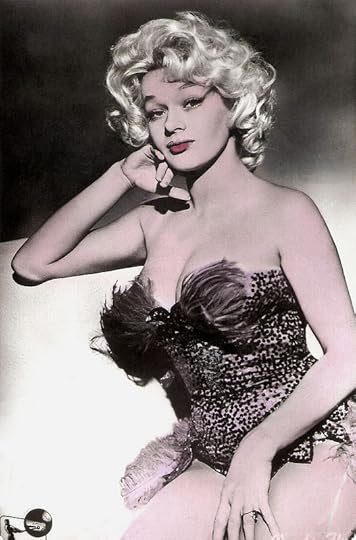
Yugoslavian postcard by Studio Sombor, no. 288. Photo: Rank.
Too Sexy For Blackpool
Vanda Hudson was born as Wanda Zaleska in Silesia, part of present-day Poland (some sources say Villefrance, France), in 1937. She moved to Great Britain in 1948 and made her screen debut in 1955. I could not find much more information about her private life on the web.
There is a 1958 press picture of her in a sexy dress in which she is presented as a cabaret singer. According to the subscript Vanda “joined the summer show on Blackpool's Central pier and brought along this gold Lame and sequin dress to wear in her act. But producer Peter Webster decided it was too sexy for Blackpool holiday makers so he ruled that the dress is out. Instead Vanda wears a less revealing simple styled dress to cover her 38-22-36 figure.”
A publicity stunt for the Central pier and for the blond bombshell?
Since the mid-1950s Vanda worked as an actress in films and TV series. According to IMDb, she made her TV-debut in 1955 in the British Detective series The Vipe (Richard Lester a.o., 1954-1960).
Her first film appearance was an uncredited part in the World War II drama Seven Thunders (Hugo Fregonese, 1957) starring Stephen Boyd.
More small parts followed in the drama Innocent Sinners (Philip Leacock, 1958), the Frankie Vaughan vehicle The Heart of a Man (Herbert Wilcox, 1959) in which she played a character called Cha Cha, and the Oscar nominated drama Libel (Anthony Asquith, 1959) starring Dirk Bogarde .
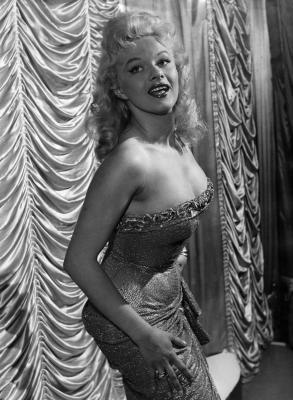
Press photo of Vanda Hudson in Blackpool in 1958. Source: Art 247.
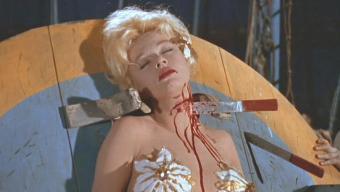
Vanda Hudson in Circus of Horrors (1960). Source: Cinemorgue.
Lurid And Risqué
In 1960 Vanda Hudson played a supporting part in the comedy Bottoms Up (Mario Zampi, 1960), just credited as Vanda.
That year she also appeared in the horror film Circus of Horrors (Sydney Hayers, 1960) starring Anton Diffring and German star Erika Remberg .
IMDb reviewer Guanche calls it “Lurid and risqué for its time, and still quite unsettling (…) This is a grim story of a doctor fleeing some botched plastic surgeries. He takes over a backwoods circus and populates it with beautiful, yet disfigured female performers whom he restores to beauty and rescues from lives of prostitution and rejection. Of course, once the circus becomes successful, the ladies no longer feel like putting up with, or putting out for him, so he devises elaborate circus ‘accidents’ to deal with their ingratitude.”
Vanda plays one of his victims, who meets a particularly gruesome end. Anton Diffring sabotages the knife-thrower's act and sexy target girl Magda von Meck (Vanda) is stabbed in the throat.

German postcard by ISV, no. 11/6.

Yugoslavian postcard by Studio Sombor, no. 288. Sent by mail in 1963. Photo: Rank.
Scandalous Luxemburg Production
Vanda Hudson’s biggest film role came the following year with her part as Fina in the romance Ticket to Paradise (Francis Searle, 1961), for which she was billed third.
More supporting parts followed in the crime films Jungle Street (Charles Saunders, 1961) starring David McCallum and Jill Ireland, and Strip Tease Murder (Ernest Morris, 1961) with Ann Lynn.
She then appeared in Double Danger (Roger Jenkins, 1961), an episode of the first season of the legendary mystery TV series The Avengers (1961-1969) starring Patrick Macnee as secret agent John Steed.
Vanda played a bit part in the comedy Father Came Too! (Peter Graham Scott, 1964) starring James Robertson Justice.
In 1963 she retired to raise her family but in 1967 she was seen in the scandalous Luxemburg production Happening (Marc Boureau, 1967) with André Dumas.
Two years later she appeared topless as an aspiring actress in the sex comedy A Promise of Bed (Derek Ford, 1969) with Victor Spinetti. It would be her final film.
Subsequently she ran the restaurant Turpin’s in Hampstead, north London.
Vanda Hudson died in 2004, aged 70.
Trailer of Circus of Horrors (1960). Source: Wicked Vision Magazine (YouTube).
Sources: The Stage, Cinemorgue, Screenweek, Art. 247 and .

Yugoslavian postcard by Studio Sombor, no. 288. Photo: Rank.
Too Sexy For Blackpool
Vanda Hudson was born as Wanda Zaleska in Silesia, part of present-day Poland (some sources say Villefrance, France), in 1937. She moved to Great Britain in 1948 and made her screen debut in 1955. I could not find much more information about her private life on the web.
There is a 1958 press picture of her in a sexy dress in which she is presented as a cabaret singer. According to the subscript Vanda “joined the summer show on Blackpool's Central pier and brought along this gold Lame and sequin dress to wear in her act. But producer Peter Webster decided it was too sexy for Blackpool holiday makers so he ruled that the dress is out. Instead Vanda wears a less revealing simple styled dress to cover her 38-22-36 figure.”
A publicity stunt for the Central pier and for the blond bombshell?
Since the mid-1950s Vanda worked as an actress in films and TV series. According to IMDb, she made her TV-debut in 1955 in the British Detective series The Vipe (Richard Lester a.o., 1954-1960).
Her first film appearance was an uncredited part in the World War II drama Seven Thunders (Hugo Fregonese, 1957) starring Stephen Boyd.
More small parts followed in the drama Innocent Sinners (Philip Leacock, 1958), the Frankie Vaughan vehicle The Heart of a Man (Herbert Wilcox, 1959) in which she played a character called Cha Cha, and the Oscar nominated drama Libel (Anthony Asquith, 1959) starring Dirk Bogarde .

Press photo of Vanda Hudson in Blackpool in 1958. Source: Art 247.

Vanda Hudson in Circus of Horrors (1960). Source: Cinemorgue.
Lurid And Risqué
In 1960 Vanda Hudson played a supporting part in the comedy Bottoms Up (Mario Zampi, 1960), just credited as Vanda.
That year she also appeared in the horror film Circus of Horrors (Sydney Hayers, 1960) starring Anton Diffring and German star Erika Remberg .
IMDb reviewer Guanche calls it “Lurid and risqué for its time, and still quite unsettling (…) This is a grim story of a doctor fleeing some botched plastic surgeries. He takes over a backwoods circus and populates it with beautiful, yet disfigured female performers whom he restores to beauty and rescues from lives of prostitution and rejection. Of course, once the circus becomes successful, the ladies no longer feel like putting up with, or putting out for him, so he devises elaborate circus ‘accidents’ to deal with their ingratitude.”
Vanda plays one of his victims, who meets a particularly gruesome end. Anton Diffring sabotages the knife-thrower's act and sexy target girl Magda von Meck (Vanda) is stabbed in the throat.

German postcard by ISV, no. 11/6.

Yugoslavian postcard by Studio Sombor, no. 288. Sent by mail in 1963. Photo: Rank.
Scandalous Luxemburg Production
Vanda Hudson’s biggest film role came the following year with her part as Fina in the romance Ticket to Paradise (Francis Searle, 1961), for which she was billed third.
More supporting parts followed in the crime films Jungle Street (Charles Saunders, 1961) starring David McCallum and Jill Ireland, and Strip Tease Murder (Ernest Morris, 1961) with Ann Lynn.
She then appeared in Double Danger (Roger Jenkins, 1961), an episode of the first season of the legendary mystery TV series The Avengers (1961-1969) starring Patrick Macnee as secret agent John Steed.
Vanda played a bit part in the comedy Father Came Too! (Peter Graham Scott, 1964) starring James Robertson Justice.
In 1963 she retired to raise her family but in 1967 she was seen in the scandalous Luxemburg production Happening (Marc Boureau, 1967) with André Dumas.
Two years later she appeared topless as an aspiring actress in the sex comedy A Promise of Bed (Derek Ford, 1969) with Victor Spinetti. It would be her final film.
Subsequently she ran the restaurant Turpin’s in Hampstead, north London.
Vanda Hudson died in 2004, aged 70.
Trailer of Circus of Horrors (1960). Source: Wicked Vision Magazine (YouTube).
Sources: The Stage, Cinemorgue, Screenweek, Art. 247 and .
Published on August 28, 2013 23:00
August 27, 2013
Else Bötticher
In the early 20th century, German actress Else Bötticher (1880-1966) performed with famous stage stars in international theatres. During the 1910s, she made several silent films. In the sound era, she returned to the cinema but then only played small roles as wives and mothers.
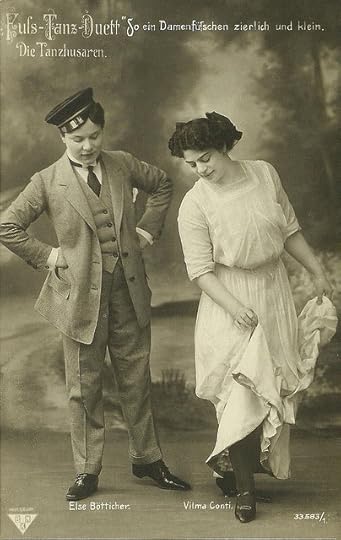
With Vilma Conti. German postcard by BNK, no. 33 583/1. Collection: Didier Hanson.
Caption: "Fuss-Tanz-Duett. So ein Damesfüsschen zierlich und klein. Die Tanzhusaren" (Foot-dance duet. Such a dainty and small lady foot. The Dance Hussars).
Acting Greats
Else Bötticher began her career at age 18 in the province. Then she played for two years Nora in theatres in the US.
Back in Germany, she was a partner of such acting greats as Josef Kainz and Max Pallenberg.
Max Reinhardt engaged her several times for his guest directions in Munich. Bötticher also repeatedly did guest performances in the Netherlands, Switzerland, Belgium, and France.
However, she worked mainly in German theatres such as the Königlichen Hoftheater zu Stuttgart (Royal Court Theatre in Stuttgart) and especially, since shortly before the First World War, in Berlin theatres such as the Trianon-Theater.
In the later years of the Weimar Republic, she was seen at the Neues Theater am Zoo and other stages.
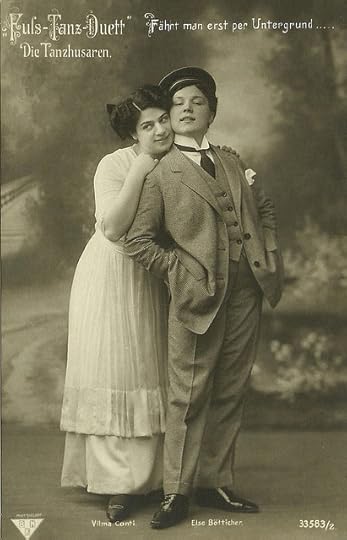
With Vilma Conti. German postcard by BNK, no. 33 583/2. Collection: Didier Hanson.
Caption: "Fuss-Tanz-Duett. Fährt man erst per Untergrund.... Die Tanzhusaren." (Foot-dance duet. You can learn only on the ground.... The Dance Hussars).
Forgotten Silent Productions
According to Wikipedia and other sources, for a long time, the cinema seemed to play only a minor role in the artistic work of Else Bötticher. However, The German Early Cinema Database shows that Bötticher appeared in several now forgotten productions during the 1910s.
Her first film was the Messter production Fräulein Leutnant/Miss Lieutenant (Carl Wilhelm, 1914) in which she played the title role opposite Albert Paulig and Hans Mierendorff .
She also appeared in the sequel Fräulein Feldgrau/Miss Feldgrau (Carl Wilhelm, 1914) again with Albert Paulig.
Her other silent films included Die Nicht aus Amerika/The Niece from America (1917), Frau Hempels Tochter/Mrs. Hempel’s Daughter (Julius Dewald, Edmund Edel, 1919) and De Profundis (Georg Jacoby, 1919) starring Ellen Richter .
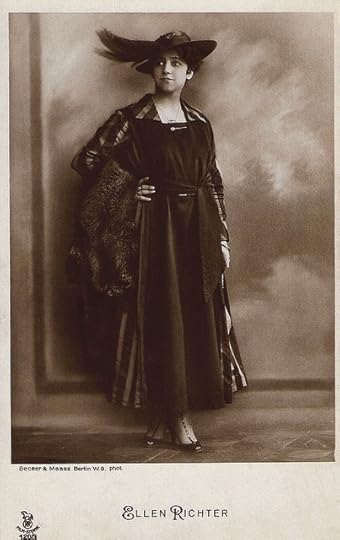
Ellen Richter . German postcard by NBC, no. 120/3. Photo: Becker & Maass, Berlin.
Mothers And Wives
After the seizure of power by the National Socialists, Else Bötticher again regularly performed before the camera. She received mostly small roles – as mothers and wives.
She played the Rectors wife and mother of Annemarie Sörensen in So ein Flegel/Such a Boor (Robert A. Stemmle, 1933) starring Heinz Rühmann in a double role, the earlier version of the hit film Die Feuerzangenbowle/The Punch Bowl (Helmut Weiss, 1943).
In 1933, she also returned to a the Berlin stage and performed at the Metropolitan Theater.
With the outbreak of the war in 1939, she ended her film work for a long time. Her theatrical commitments were also limited.
After the war, the elderly actress only played guest roles.
Her final film appearance was a bit part in Mein Vater, der Schauspieler/My Father the Actor (Robert Siodmak, 1956) starring O.W. Fischer .
In 1966, Else Bötticher died in Berlin. She was 85.
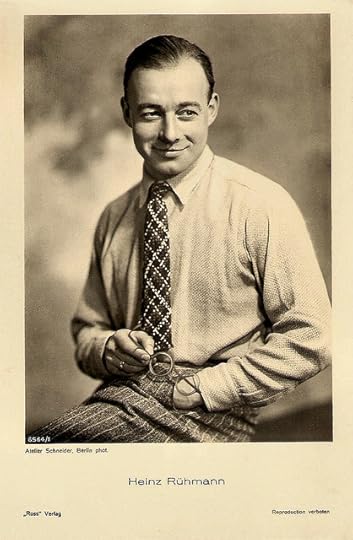
Heinz Rühmann . German postcard by Ross Verlag, no. 6564/1, 1931-1932. Photo: Atelier Schneider, Berlin.
Sources: The German Early Cinema Database, Filmportal.de, Wikipedia (German), and .

With Vilma Conti. German postcard by BNK, no. 33 583/1. Collection: Didier Hanson.
Caption: "Fuss-Tanz-Duett. So ein Damesfüsschen zierlich und klein. Die Tanzhusaren" (Foot-dance duet. Such a dainty and small lady foot. The Dance Hussars).
Acting Greats
Else Bötticher began her career at age 18 in the province. Then she played for two years Nora in theatres in the US.
Back in Germany, she was a partner of such acting greats as Josef Kainz and Max Pallenberg.
Max Reinhardt engaged her several times for his guest directions in Munich. Bötticher also repeatedly did guest performances in the Netherlands, Switzerland, Belgium, and France.
However, she worked mainly in German theatres such as the Königlichen Hoftheater zu Stuttgart (Royal Court Theatre in Stuttgart) and especially, since shortly before the First World War, in Berlin theatres such as the Trianon-Theater.
In the later years of the Weimar Republic, she was seen at the Neues Theater am Zoo and other stages.

With Vilma Conti. German postcard by BNK, no. 33 583/2. Collection: Didier Hanson.
Caption: "Fuss-Tanz-Duett. Fährt man erst per Untergrund.... Die Tanzhusaren." (Foot-dance duet. You can learn only on the ground.... The Dance Hussars).
Forgotten Silent Productions
According to Wikipedia and other sources, for a long time, the cinema seemed to play only a minor role in the artistic work of Else Bötticher. However, The German Early Cinema Database shows that Bötticher appeared in several now forgotten productions during the 1910s.
Her first film was the Messter production Fräulein Leutnant/Miss Lieutenant (Carl Wilhelm, 1914) in which she played the title role opposite Albert Paulig and Hans Mierendorff .
She also appeared in the sequel Fräulein Feldgrau/Miss Feldgrau (Carl Wilhelm, 1914) again with Albert Paulig.
Her other silent films included Die Nicht aus Amerika/The Niece from America (1917), Frau Hempels Tochter/Mrs. Hempel’s Daughter (Julius Dewald, Edmund Edel, 1919) and De Profundis (Georg Jacoby, 1919) starring Ellen Richter .

Ellen Richter . German postcard by NBC, no. 120/3. Photo: Becker & Maass, Berlin.
Mothers And Wives
After the seizure of power by the National Socialists, Else Bötticher again regularly performed before the camera. She received mostly small roles – as mothers and wives.
She played the Rectors wife and mother of Annemarie Sörensen in So ein Flegel/Such a Boor (Robert A. Stemmle, 1933) starring Heinz Rühmann in a double role, the earlier version of the hit film Die Feuerzangenbowle/The Punch Bowl (Helmut Weiss, 1943).
In 1933, she also returned to a the Berlin stage and performed at the Metropolitan Theater.
With the outbreak of the war in 1939, she ended her film work for a long time. Her theatrical commitments were also limited.
After the war, the elderly actress only played guest roles.
Her final film appearance was a bit part in Mein Vater, der Schauspieler/My Father the Actor (Robert Siodmak, 1956) starring O.W. Fischer .
In 1966, Else Bötticher died in Berlin. She was 85.

Heinz Rühmann . German postcard by Ross Verlag, no. 6564/1, 1931-1932. Photo: Atelier Schneider, Berlin.
Sources: The German Early Cinema Database, Filmportal.de, Wikipedia (German), and .
Published on August 27, 2013 23:00
Paul van Yperen's Blog
- Paul van Yperen's profile
- 13 followers
Paul van Yperen isn't a Goodreads Author
(yet),
but they
do have a blog,
so here are some recent posts imported from
their feed.



